If you like anything, you hate what destroys it. The worst are things that destroy it from within. These usually pretend to be it, then use it for their own purposes, corrupting it. Like a cancer or disease.
 The best example in our time of course is the hipster. The hipster is the eternal party of one: he or she does everything to make him or herself look good to others. They “like” music because they want to look like the image of that music. They then have to be a very big deal, so they make their own art or music which is shallow and surface-oriented, but they trick it out to make it look cool.
The best example in our time of course is the hipster. The hipster is the eternal party of one: he or she does everything to make him or herself look good to others. They “like” music because they want to look like the image of that music. They then have to be a very big deal, so they make their own art or music which is shallow and surface-oriented, but they trick it out to make it look cool.
In metal, we have the equivalent. They come in many forms. Some like to think they’re smart, so they like dumb kiddie music tricked out like prog rock. Some like to think they’re cool, so they like angry pointless three-chord bands with weird names and gimmicks. Some like to be political, so they pick bands that are anarchists or Nazis. They’re not thinking about the music; they’re thinking about how cool it makes them look. The best music to make you look cool is basically the same crap you get on MTV, but with a cool image. They are a cancer on metal.
And they have some favorite bands. Not coincidentally, these bands are the worst depthless and pointless stuff to hit metal. Note bene: This list is about music I hate, not people I hate. Some people whose music I like hate me, and some people I hate make great music. Some people who I like also make terrible music. I can only tell it as I see it and hope the pagan gods sort out the fracas.
Here’s the list:
Dethklok
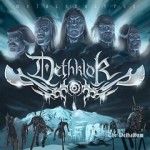 How can you hate a cartoon? It’s supposed to be funny. It makes fun of metal’s weaknesses. Ergo, by the passive-aggressive inversion, if you dislike this you’re afraid to laugh at yourself. And who likes someone who can’t laugh at himself? Except that joke bands have always been stupid, with the joke/hype/trend coming before the music, and Dethklok is no exception. Recycled riffs. Moronic pop song structures. TV commercial jingle-like melodies. And bad guitar playing that dumbs metal down to MTV levels. Let’s turn it around on them: who has a need to look like they can laugh at themselves? Why, people who cannot, of course. But they don’t want you to know that.
How can you hate a cartoon? It’s supposed to be funny. It makes fun of metal’s weaknesses. Ergo, by the passive-aggressive inversion, if you dislike this you’re afraid to laugh at yourself. And who likes someone who can’t laugh at himself? Except that joke bands have always been stupid, with the joke/hype/trend coming before the music, and Dethklok is no exception. Recycled riffs. Moronic pop song structures. TV commercial jingle-like melodies. And bad guitar playing that dumbs metal down to MTV levels. Let’s turn it around on them: who has a need to look like they can laugh at themselves? Why, people who cannot, of course. But they don’t want you to know that.
Cannibal Corpse
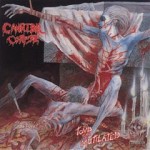 When I was a wee liberal, I never thought much of Cannibal Corpse until I read their immensely misogynistic lyrics. Then I decided to hate them. Upon reflection, however, what I really hate about this band is its falseness. They studied metal in the early 1990s, and came up with a pre-chewed version. Taking their style from Suffocation, and their songwriting from Malevolent Creation, they bashed out these simple hymns and instead of having an idea behind them like “only death is real,” they just tried to be offensive and gross. How junior high school! Even more, they have gotten more repetitive and grind-you-down-with-simple-stuff as they years have gone on. I couldn’t hate this band more. But, having met them and seen they are nice intelligent fellows, my only conclusion can be that this band is a pure money-maker — and they about admitted as much.
When I was a wee liberal, I never thought much of Cannibal Corpse until I read their immensely misogynistic lyrics. Then I decided to hate them. Upon reflection, however, what I really hate about this band is its falseness. They studied metal in the early 1990s, and came up with a pre-chewed version. Taking their style from Suffocation, and their songwriting from Malevolent Creation, they bashed out these simple hymns and instead of having an idea behind them like “only death is real,” they just tried to be offensive and gross. How junior high school! Even more, they have gotten more repetitive and grind-you-down-with-simple-stuff as they years have gone on. I couldn’t hate this band more. But, having met them and seen they are nice intelligent fellows, my only conclusion can be that this band is a pure money-maker — and they about admitted as much.
Opeth
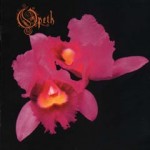 Life isn’t fair to you. You have few friends. You haven’t succeeded at anything, school or otherwise. Even your parents think they consumed too much Bisphenol-A before conceiving you. But you’ve found a new weapon; you’re going to show everyone you’re better than them. Enter the fake progressive rock band. Opeth take very simple songs and dress them up with prog rock lite flourishes, and “unexpected” changes like ZOMG going from acoustic to distorted on the chorus, because they know that all you low self-esteem cases want a reason to seem smarter and more profound than the rest of us. Well, now you have it. Opeth “sounds like” prog even if it has none of what made prog great: real musical development, song structures that build upon themes instead of being random, and truly mindblowing chops. Instead, you get watered down Rush riffs and random songs, all with a lot of guilt and bleeding-heart sympathy because they, Opeth, know you are a loser. Stop comparing homosexuals and Mac users to Opeth. It’s an undeserved insult to homosexuals.
Life isn’t fair to you. You have few friends. You haven’t succeeded at anything, school or otherwise. Even your parents think they consumed too much Bisphenol-A before conceiving you. But you’ve found a new weapon; you’re going to show everyone you’re better than them. Enter the fake progressive rock band. Opeth take very simple songs and dress them up with prog rock lite flourishes, and “unexpected” changes like ZOMG going from acoustic to distorted on the chorus, because they know that all you low self-esteem cases want a reason to seem smarter and more profound than the rest of us. Well, now you have it. Opeth “sounds like” prog even if it has none of what made prog great: real musical development, song structures that build upon themes instead of being random, and truly mindblowing chops. Instead, you get watered down Rush riffs and random songs, all with a lot of guilt and bleeding-heart sympathy because they, Opeth, know you are a loser. Stop comparing homosexuals and Mac users to Opeth. It’s an undeserved insult to homosexuals.
Meshuggah
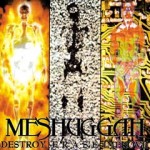 I was talking with a Texas technical deathgrind master and he wrote a formula for me: Meshuggah = lots of clueless fans x lack of musical knowledge. If you have played guitar and learned theory, you know how trivial this band is. It’s basically a jazz percussion approach to metal rhythm guitar. Lots of offbeats within offbeats, if you know what I mean. No melody, no song development. In fact, song structures are linear in that they follow the sub-division of beats to a riff, expanding over time in a circular fashion. It’s really boring. But if you want to seem like you got the ultimate in technical metal, you’ll think you’re really cool for liking this distracted, random, artless band. Same critique applies to Necrophagist. They both attract people who want to be cool and smart, but have no knowledge of how the world works, which is why people are Meshuggah fans for exactly two years and then go on to liking Deerhoof and Yoko Ono.
I was talking with a Texas technical deathgrind master and he wrote a formula for me: Meshuggah = lots of clueless fans x lack of musical knowledge. If you have played guitar and learned theory, you know how trivial this band is. It’s basically a jazz percussion approach to metal rhythm guitar. Lots of offbeats within offbeats, if you know what I mean. No melody, no song development. In fact, song structures are linear in that they follow the sub-division of beats to a riff, expanding over time in a circular fashion. It’s really boring. But if you want to seem like you got the ultimate in technical metal, you’ll think you’re really cool for liking this distracted, random, artless band. Same critique applies to Necrophagist. They both attract people who want to be cool and smart, but have no knowledge of how the world works, which is why people are Meshuggah fans for exactly two years and then go on to liking Deerhoof and Yoko Ono.
Cradle of Filth
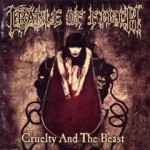 What’s the best new thing? Something that’s the old thing… but “sounds” new! You can make anything sound different with different production, playing at different speeds, using black metal voices or more distortion. And so if you take Iron Maiden, throw in some fast melodic death metal riffs, but keep it nice and tasty pentatonic, you’ll have the perfect product. People can be undercover conformists. They can look like rebels for listening to this angry sounding music, but underneath it, there’s that same old happy Iron Maiden that millions of people the world over like. Cradle of Filth is the perfect product and millions bought it, then immediately forgot them, to the point where you don’t hear about them at all. But this was a huge trend and basically boring music with a lot of drama surrounding it.
What’s the best new thing? Something that’s the old thing… but “sounds” new! You can make anything sound different with different production, playing at different speeds, using black metal voices or more distortion. And so if you take Iron Maiden, throw in some fast melodic death metal riffs, but keep it nice and tasty pentatonic, you’ll have the perfect product. People can be undercover conformists. They can look like rebels for listening to this angry sounding music, but underneath it, there’s that same old happy Iron Maiden that millions of people the world over like. Cradle of Filth is the perfect product and millions bought it, then immediately forgot them, to the point where you don’t hear about them at all. But this was a huge trend and basically boring music with a lot of drama surrounding it.
Ulver
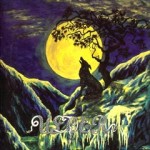 In theory, I would like this band as they have a formal background in music and clearly know theory. However, they have no souls. They made the plasticine “Nattens Madrigal” by imitating black metal bands, but playing indie rock songs in the black metal style. Sweet, twee, poignant, ironic melodies and pop song structures defined that CD. Ever since then, Ulver has made a career out of being “different.” They make electronica that sounds like an angrier version of all other electronica! They make concept albums that sound like two indie rock CDs with the lyrics re-written! They make bold public statements and image changes like Bono of U2! What they don’t do, however, is understand metal and what makes it great. Instead, they try to make metal into the genre they belong in, which is indie rock, and dumb it down accordingly. Again, conformity disguised as non-conformity, because if you tell everyone you’re a non-conformist, you can’t possibly be a secret sheep, amirite?
In theory, I would like this band as they have a formal background in music and clearly know theory. However, they have no souls. They made the plasticine “Nattens Madrigal” by imitating black metal bands, but playing indie rock songs in the black metal style. Sweet, twee, poignant, ironic melodies and pop song structures defined that CD. Ever since then, Ulver has made a career out of being “different.” They make electronica that sounds like an angrier version of all other electronica! They make concept albums that sound like two indie rock CDs with the lyrics re-written! They make bold public statements and image changes like Bono of U2! What they don’t do, however, is understand metal and what makes it great. Instead, they try to make metal into the genre they belong in, which is indie rock, and dumb it down accordingly. Again, conformity disguised as non-conformity, because if you tell everyone you’re a non-conformist, you can’t possibly be a secret sheep, amirite?
Necrophagist
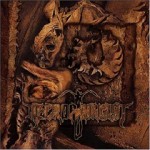 Musical illiteracy is a ripoff musician’s best friend. People do not understand how melodies should develop over the course of a song, and how technical playing without a goal creates chaos and fragments your consciousness, not builds on it. Necrophagist play melodies, all right. They play short blasts of melody over and over again, very quickly. Then the song jumps to something unrelated and obviously “different.” It’s like a sampler plate at a restaurant, a little bit of everything so you don’t have to choose what you want. Then it jumps back. And back again. And then it’s over. The vocals are like the chant of an auctioneer. The riffs are advancing guitar exercises. Drums are what you’d expect from a failed jazz drummer on tons of meth trying to cover Nine Inch Nails. The end result? A lot of distracting, directionless crap. But people like it because it’s more technical than what you are listening to, therefore they must be smarter. QED, muddafugga.
Musical illiteracy is a ripoff musician’s best friend. People do not understand how melodies should develop over the course of a song, and how technical playing without a goal creates chaos and fragments your consciousness, not builds on it. Necrophagist play melodies, all right. They play short blasts of melody over and over again, very quickly. Then the song jumps to something unrelated and obviously “different.” It’s like a sampler plate at a restaurant, a little bit of everything so you don’t have to choose what you want. Then it jumps back. And back again. And then it’s over. The vocals are like the chant of an auctioneer. The riffs are advancing guitar exercises. Drums are what you’d expect from a failed jazz drummer on tons of meth trying to cover Nine Inch Nails. The end result? A lot of distracting, directionless crap. But people like it because it’s more technical than what you are listening to, therefore they must be smarter. QED, muddafugga.
Baroness
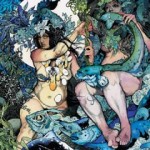 If your douchey alt-rock band fails, throw on the distortion and play really slowly with obvious stoner themes. Now, thanks to the magic of record company marketing, you’re the latest metal trend! Work hard before your 15 minutes (or 18 months, at which point all your fans get promoted to head waiter) of fame evaporates. You’ll make money by making them feel like they’ve discovered the one secret rebellion that will really upset their parents. It’s like a giant tribe of stoners, descending on the world, man. They’re going to make everything right or at least feel all-right. Do you realize you’re listening to the same sad crap your grandparents grew out of in the 1970s?
If your douchey alt-rock band fails, throw on the distortion and play really slowly with obvious stoner themes. Now, thanks to the magic of record company marketing, you’re the latest metal trend! Work hard before your 15 minutes (or 18 months, at which point all your fans get promoted to head waiter) of fame evaporates. You’ll make money by making them feel like they’ve discovered the one secret rebellion that will really upset their parents. It’s like a giant tribe of stoners, descending on the world, man. They’re going to make everything right or at least feel all-right. Do you realize you’re listening to the same sad crap your grandparents grew out of in the 1970s?
In Flames
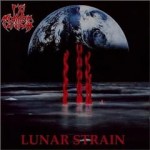 First there was At the Gates, who made The Red in the Sky is Ours, and blew us all away. Then came black metal. Then came Dissection. Then someone wondered what would happen if you took Dissection and dumbed it down, made it a little more like regular rock ‘n’ roll, and claimed it was new and exciting. I guess that person was a genius because people still take In Flames seriously, although at the time their first CD came out metalheads universally viewed them as clueless, wimpy and latecoming carpetbaggers. These guys are ripping off Iron Maiden on every album. They get away with it because their fans want to think they’re new and fresh and evil, not warmed-over 1978 heavy metal. These retreads from the mid-1990s keep puking out the crap and for some reason, people still discuss them.
First there was At the Gates, who made The Red in the Sky is Ours, and blew us all away. Then came black metal. Then came Dissection. Then someone wondered what would happen if you took Dissection and dumbed it down, made it a little more like regular rock ‘n’ roll, and claimed it was new and exciting. I guess that person was a genius because people still take In Flames seriously, although at the time their first CD came out metalheads universally viewed them as clueless, wimpy and latecoming carpetbaggers. These guys are ripping off Iron Maiden on every album. They get away with it because their fans want to think they’re new and fresh and evil, not warmed-over 1978 heavy metal. These retreads from the mid-1990s keep puking out the crap and for some reason, people still discuss them.
Rammstein
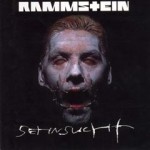 Once there was a band called Ministry. They realized that no one had done IDM with guitars yet. So they made this style of really simple metal/punk/rock with industrial beats and weird background samples, and a huge audience went crazy for it. The same year, Nine Inch Nails made an album that was equal parts dance and hatred, with lots of keyboards and some buzzy guitars. Ever since then, people have been trying to recapture this audience because they’re still out there. Rammstein is the industrial hard rock version of Mickie Krause, with a heavy dose of Tool in the backdoor. They like to be shocking. It’s really a tiresome play that happens every generation as kids try to shock their parents and teachers. But you can’t shock the world at large because it doesn’t care. It’s more apathetic, cynical, nihilistic and cruel than any candy-industrial rock band is going to be. So Rammstein are in the big picture like greeting cards. They tell you a little bit of truth, put some flowers and kittens around it, and you pay a 1500% markup and go home happy, but confused. Just go listen to Ministry already.
Once there was a band called Ministry. They realized that no one had done IDM with guitars yet. So they made this style of really simple metal/punk/rock with industrial beats and weird background samples, and a huge audience went crazy for it. The same year, Nine Inch Nails made an album that was equal parts dance and hatred, with lots of keyboards and some buzzy guitars. Ever since then, people have been trying to recapture this audience because they’re still out there. Rammstein is the industrial hard rock version of Mickie Krause, with a heavy dose of Tool in the backdoor. They like to be shocking. It’s really a tiresome play that happens every generation as kids try to shock their parents and teachers. But you can’t shock the world at large because it doesn’t care. It’s more apathetic, cynical, nihilistic and cruel than any candy-industrial rock band is going to be. So Rammstein are in the big picture like greeting cards. They tell you a little bit of truth, put some flowers and kittens around it, and you pay a 1500% markup and go home happy, but confused. Just go listen to Ministry already.
Cynic
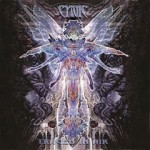 This band started out really well with a solid demo that sounded like it was one third speed metal, one third death metal, and about a third jazz fusion. No problem; we all want to be Atheist. But then immediately the neurosis started. First they tried to get more fruity sounds in their instrumentation, then they added the harmonized vocals, and finally, they just admitted they didn’t want to be death metal and quit, after a decent first album, Focus. Then in 2009 they decided to really ruin their reputations except among morons. They piled together a bunch of jazz cliches and metal cliches, and threw them at each other, then overplayed the rest. This is because they know their fans know little about music but want to seem like they do. If you take a few guitar lessons, you really want to show you’ve got that knowledge, so you start listening to Big Important Concept bands and genres like jazz, which is sort of like degraded classical music for people who need ideas pre-chewed. Cynic fans like to act outraged that anyone cannot see the greatness and complexity of Cynic, and use that to imply that the rest of us are stupid, when if they took the time to tab out these songs, they’d see that they are random bits stuck together with excessive guitar licks.
This band started out really well with a solid demo that sounded like it was one third speed metal, one third death metal, and about a third jazz fusion. No problem; we all want to be Atheist. But then immediately the neurosis started. First they tried to get more fruity sounds in their instrumentation, then they added the harmonized vocals, and finally, they just admitted they didn’t want to be death metal and quit, after a decent first album, Focus. Then in 2009 they decided to really ruin their reputations except among morons. They piled together a bunch of jazz cliches and metal cliches, and threw them at each other, then overplayed the rest. This is because they know their fans know little about music but want to seem like they do. If you take a few guitar lessons, you really want to show you’ve got that knowledge, so you start listening to Big Important Concept bands and genres like jazz, which is sort of like degraded classical music for people who need ideas pre-chewed. Cynic fans like to act outraged that anyone cannot see the greatness and complexity of Cynic, and use that to imply that the rest of us are stupid, when if they took the time to tab out these songs, they’d see that they are random bits stuck together with excessive guitar licks.
Wolves in the Throne Room
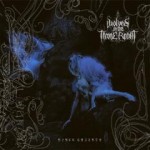 You’re at home listening to your new outrageous indie rock CD when your Mom comes home and catches you. It turns out she has the same CD. In the car. She and her friends listen to it, your Dad likes it, even your grandfather thinks it’s OK, because indie rock is the same crap they’ve made since 1952 or so, just with more wailing and self-pity (and minor chords). So you storm out of the house thinking, “I’ll show them!” You go to the record store and decide to skip past all the music for healthy people, you’ll get metal. And then you find Wolves in the Throne Room. It’s like that outrageous metal, but it’s safe. It contains safe moral opinions that people at your church and Democratic fund raiser would agree with. It’s basically indie rock, but they play it like it was black metal. And it’s totally boring, so you can have it droning in the background while you wonder if anyone ever anywhere has suffered as much as you have.
You’re at home listening to your new outrageous indie rock CD when your Mom comes home and catches you. It turns out she has the same CD. In the car. She and her friends listen to it, your Dad likes it, even your grandfather thinks it’s OK, because indie rock is the same crap they’ve made since 1952 or so, just with more wailing and self-pity (and minor chords). So you storm out of the house thinking, “I’ll show them!” You go to the record store and decide to skip past all the music for healthy people, you’ll get metal. And then you find Wolves in the Throne Room. It’s like that outrageous metal, but it’s safe. It contains safe moral opinions that people at your church and Democratic fund raiser would agree with. It’s basically indie rock, but they play it like it was black metal. And it’s totally boring, so you can have it droning in the background while you wonder if anyone ever anywhere has suffered as much as you have.
Boris
 Wait — it’s Yoko Ono! No, it’s Deerhoof! No, it’s another chick wailing her head off with the coordination of a trisomy 21 patient. She wants us to think this is profound and progressive and new because normally, people don’t try to repackage SUCKS as SUCCESS. But that’s her gimmick, and the gimmick of most modern art. This is unusual because it’s illogical. If you don’t understand it, you’re little people — fetch me a sandwich. Only the enlightened pure and true understand our indie rock that we play (occasionally) as if it were black metal. Nevermind that black metal already existed. We want to remake it in our new and improved style. Which suspiciously resembles normal indie rock, but did we mention, there’s a chick wailing like a burnt Down’s syndrome kid? The fans can’t tell the difference because they learn to play guitars and basic music theory, but never think about what gives music meaning, because that would require they look into their own souls. And you can’t look into your soul, and still think you’re the whole world. Hipsters love this music because each one of them is a party of one and the rest of the world just doesn’t exist! So they call it brilliant. On and on, South of Heaven.
Wait — it’s Yoko Ono! No, it’s Deerhoof! No, it’s another chick wailing her head off with the coordination of a trisomy 21 patient. She wants us to think this is profound and progressive and new because normally, people don’t try to repackage SUCKS as SUCCESS. But that’s her gimmick, and the gimmick of most modern art. This is unusual because it’s illogical. If you don’t understand it, you’re little people — fetch me a sandwich. Only the enlightened pure and true understand our indie rock that we play (occasionally) as if it were black metal. Nevermind that black metal already existed. We want to remake it in our new and improved style. Which suspiciously resembles normal indie rock, but did we mention, there’s a chick wailing like a burnt Down’s syndrome kid? The fans can’t tell the difference because they learn to play guitars and basic music theory, but never think about what gives music meaning, because that would require they look into their own souls. And you can’t look into your soul, and still think you’re the whole world. Hipsters love this music because each one of them is a party of one and the rest of the world just doesn’t exist! So they call it brilliant. On and on, South of Heaven.
Sunn o)))
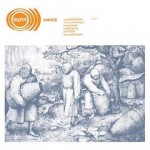 Stephen O’Malley is a fantastic person, a great artist, the world’s best stoner and truly, an insightful individual. However, he sold his soul to the devil with this hipster project. If you live in Austin, or are intimately familiar with the apps on your iPhone, this might be for you. It’s concept art. That means that they think up an idea that would be unusual, and make it in musical form, even if it’s boring, because it has symbolic value that us peons cannot decipher because we have tiny peon brains. So when someone plays a guitar really slowly for ten minutes and never develops a song out of it, you either get it because you’re a genius, or you’re an intolerant backward moron with a peon brain. They even get funky and throw in “found sounds” and sometimes have an orchestra show up and try to riff on the two notes allotted for each song. The word “sophomoric” describes people who take a little knowledge and use it to pretend they understand the world. It also describes all Sunn o))) fans.
Stephen O’Malley is a fantastic person, a great artist, the world’s best stoner and truly, an insightful individual. However, he sold his soul to the devil with this hipster project. If you live in Austin, or are intimately familiar with the apps on your iPhone, this might be for you. It’s concept art. That means that they think up an idea that would be unusual, and make it in musical form, even if it’s boring, because it has symbolic value that us peons cannot decipher because we have tiny peon brains. So when someone plays a guitar really slowly for ten minutes and never develops a song out of it, you either get it because you’re a genius, or you’re an intolerant backward moron with a peon brain. They even get funky and throw in “found sounds” and sometimes have an orchestra show up and try to riff on the two notes allotted for each song. The word “sophomoric” describes people who take a little knowledge and use it to pretend they understand the world. It also describes all Sunn o))) fans.
Pantera
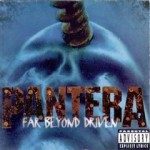 We’ve saved the best for last. Rocket back to the late 1980s with me. Your hair metal band just failed because you look gay even to homosexual rights activists, and not in the good way. In the supersonic stupid way. You’re out of money, and this band named Metallica has just raised the stakes for metal bands by being harder and faster. They’re harder and faster, while you’re prancing and pouting. So what do you do? Turn that fear of your masculinity outward, and become a tough-guy version of Metallica. This is what Pantera did with their first “real” album, Cowboys From Hell. Metallica riffs in simple songs with lots of ‘roid rage posturing. It got worse after that as Pantera added more trends to their faux metal charm bracelet, dabbling in death metal and blues rock, until their music ended up a mishmash of completely random influences. People like this band because it’s a good introduction to basic rock guitar. They can understand it, and it also appeals to their wounded masculinity. If you buy a Pantera album, the thinking goes, you’ll become more tough and angry like Phil Anselmo. People from the real world know that’s not true, which is why most of Pantera’s fans are skinny teenagers trying to figure out which fraternity will be most likely to help them score someday.
We’ve saved the best for last. Rocket back to the late 1980s with me. Your hair metal band just failed because you look gay even to homosexual rights activists, and not in the good way. In the supersonic stupid way. You’re out of money, and this band named Metallica has just raised the stakes for metal bands by being harder and faster. They’re harder and faster, while you’re prancing and pouting. So what do you do? Turn that fear of your masculinity outward, and become a tough-guy version of Metallica. This is what Pantera did with their first “real” album, Cowboys From Hell. Metallica riffs in simple songs with lots of ‘roid rage posturing. It got worse after that as Pantera added more trends to their faux metal charm bracelet, dabbling in death metal and blues rock, until their music ended up a mishmash of completely random influences. People like this band because it’s a good introduction to basic rock guitar. They can understand it, and it also appeals to their wounded masculinity. If you buy a Pantera album, the thinking goes, you’ll become more tough and angry like Phil Anselmo. People from the real world know that’s not true, which is why most of Pantera’s fans are skinny teenagers trying to figure out which fraternity will be most likely to help them score someday.
There you have it: a catalogue of fail. Or rather, fail that is highly praised by those who know not much of anything. Naturally, products designed for idiots that make idiots feel like geniuses are big sellers, so you’ll have to suffer seeing this bands around for a while yet. But as time goes on, it’s amazing how the crap gets filtered out and the really powerful stuff endures.
Tags: Baroness, boris, cannibal corpse, cradle of filth, cynic, dethklok, in flames, meshuggah, necrophagist, opeth, pantera, Rammstein, sunn o))), Ulver, wolves in the throne room
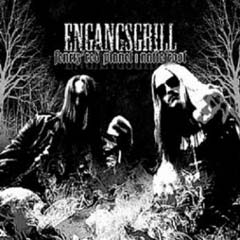 We’re going to talk about the first band here, Fenriz’ Red Planet, because Nattefrost is forgettable 1970s punk rock dressed up as early 1980s black metal. This band is a hybrid between doom metal, 1970s heavy guitar jam, and what they call stoner doom now but was recognizable in St. Vitus, Pentagram and Sleep for many years. The production approach and song style is closest to 1970s heavy guitar rock, like Cream or even Led Zeppelin, in that songs are verse/chorus works with a big fat diversion stuck in the middle that may run through a couple of riffs but comes back into key and rhythm so the cycle can spin again. But over half of the riffs are straight out of old school 1980s doom metal, and that would be St. Vitus and Pentagram but also late-blooming NWOBHM with a doom edge like Witchfinder General and Budgie. It’s not exciting; if anything, it sounds like a demo where the band hasn’t yet finalized direction and aesthetic. However, it is good; these songs have character and a spirit to them which you cannot get anywhere else. You can hear a few lifts from Fenriz’ folk/metal project Storm and one or two similar themes to Darkthrone, but this CD doesn’t need to namedrop to stand on its own. They named it “Engangsgrill,” which apparently is a type of disposable barbecue, which fits exactly the kind of sloppy rock/metal hybrid you have here: pickup trucks headed to the country with a keg, a bong and some friends, followed by a weekend of the best neighborhood bands jamming, society gets forgotten until on Monday morning you drive back with a mouth full of ash and the kind of diluted hangover that comes from cheap beer in constant consumption.
We’re going to talk about the first band here, Fenriz’ Red Planet, because Nattefrost is forgettable 1970s punk rock dressed up as early 1980s black metal. This band is a hybrid between doom metal, 1970s heavy guitar jam, and what they call stoner doom now but was recognizable in St. Vitus, Pentagram and Sleep for many years. The production approach and song style is closest to 1970s heavy guitar rock, like Cream or even Led Zeppelin, in that songs are verse/chorus works with a big fat diversion stuck in the middle that may run through a couple of riffs but comes back into key and rhythm so the cycle can spin again. But over half of the riffs are straight out of old school 1980s doom metal, and that would be St. Vitus and Pentagram but also late-blooming NWOBHM with a doom edge like Witchfinder General and Budgie. It’s not exciting; if anything, it sounds like a demo where the band hasn’t yet finalized direction and aesthetic. However, it is good; these songs have character and a spirit to them which you cannot get anywhere else. You can hear a few lifts from Fenriz’ folk/metal project Storm and one or two similar themes to Darkthrone, but this CD doesn’t need to namedrop to stand on its own. They named it “Engangsgrill,” which apparently is a type of disposable barbecue, which fits exactly the kind of sloppy rock/metal hybrid you have here: pickup trucks headed to the country with a keg, a bong and some friends, followed by a weekend of the best neighborhood bands jamming, society gets forgotten until on Monday morning you drive back with a mouth full of ash and the kind of diluted hangover that comes from cheap beer in constant consumption.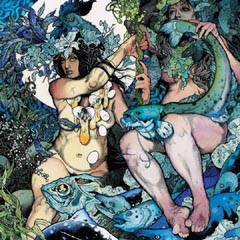 Oh neat, an emo/stoner metal hybrid with lots of indie and punk rock touches. If you can imagine Neurosis and Jawbreaker making sweet love with newer Sleep, and throwing in tons of stuff from the heavy metal and indie rock canons, you’ll have a good image of what this cheeseball release has to offer. From the way the labels and the big industry reviewers — who have about five minutes to hear each CD, and put them on in the background while socializing for two weeks, then forget about them — went on about this CD, you’d think it was the second coming of innovation itself. Instead, it’s stale and completely loses what’s good about metal and punk, converging on a mean that’s closer to your run-of-the-mill hipster band. This is awful.
Oh neat, an emo/stoner metal hybrid with lots of indie and punk rock touches. If you can imagine Neurosis and Jawbreaker making sweet love with newer Sleep, and throwing in tons of stuff from the heavy metal and indie rock canons, you’ll have a good image of what this cheeseball release has to offer. From the way the labels and the big industry reviewers — who have about five minutes to hear each CD, and put them on in the background while socializing for two weeks, then forget about them — went on about this CD, you’d think it was the second coming of innovation itself. Instead, it’s stale and completely loses what’s good about metal and punk, converging on a mean that’s closer to your run-of-the-mill hipster band. This is awful.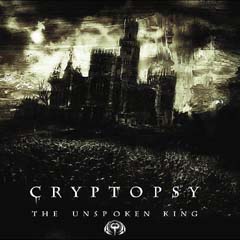 This is what’s left of the band that made None So Vile? The neatly structured, compact death metal has been replaced with blasting metalcore. Metalcore, as you may know, is kind of a garbage plate for underground metal and punk. Based around the interpretation of technical metal into punk structures that Human Remains showed us, metalcore loves randomness in circular song structures, so you get ten minimally-related riffs linked by a breakdown and a few slow chants, and then the whole thing repeats, and then the song ends. It’s music for a fragmented mind and as a result, has the IQ of a headless chicken watching daytime TV. Cryptopsy utterly fails to make coherent music out of this style as their countrymen Neuraxis eventually did, and instead defecate this collection of random riffs based around an egodramatic vocal track. It’s total garbage for morons.
This is what’s left of the band that made None So Vile? The neatly structured, compact death metal has been replaced with blasting metalcore. Metalcore, as you may know, is kind of a garbage plate for underground metal and punk. Based around the interpretation of technical metal into punk structures that Human Remains showed us, metalcore loves randomness in circular song structures, so you get ten minimally-related riffs linked by a breakdown and a few slow chants, and then the whole thing repeats, and then the song ends. It’s music for a fragmented mind and as a result, has the IQ of a headless chicken watching daytime TV. Cryptopsy utterly fails to make coherent music out of this style as their countrymen Neuraxis eventually did, and instead defecate this collection of random riffs based around an egodramatic vocal track. It’s total garbage for morons.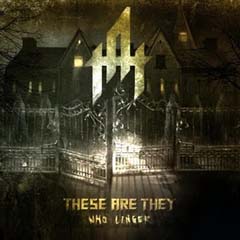 Imagine Iron Maiden doing a simplified version of 1990s Demigod or Amorphis. This CD is unique in that it successfully applies both (a) the old school death metal style and (b) a heavy metal, harmonized-guitar, bouncy riff style — and does it by coming up with a melodic phrase and answer, and using these to make layers of verse and chorus. Play riff; play notes of riff in variation of rhythm; harmonize guitars and repeat, then cycle. The choruses do the same. Nothing sounds out of place, and the deep guttural voice guides it along, but it seems entirely out of place when the heavy metal riffs and trills come into play. In addition, the riff salad of death metal isn’t here; like rock or indie, this rides one pattern for verse and one for chorus, and much variation is not to be found, which probably places this out of the range of old school death metal fans. Still, these are quality riffs and excellent use of basic harmony, which makes this easy listening and because it is not random, a great improvement on the metalcore-heavy stuff we hear daily. For albums like later Bolt Thrower, which tried to make a heavy metal/death metal hybrid, this is probably the best so far.
Imagine Iron Maiden doing a simplified version of 1990s Demigod or Amorphis. This CD is unique in that it successfully applies both (a) the old school death metal style and (b) a heavy metal, harmonized-guitar, bouncy riff style — and does it by coming up with a melodic phrase and answer, and using these to make layers of verse and chorus. Play riff; play notes of riff in variation of rhythm; harmonize guitars and repeat, then cycle. The choruses do the same. Nothing sounds out of place, and the deep guttural voice guides it along, but it seems entirely out of place when the heavy metal riffs and trills come into play. In addition, the riff salad of death metal isn’t here; like rock or indie, this rides one pattern for verse and one for chorus, and much variation is not to be found, which probably places this out of the range of old school death metal fans. Still, these are quality riffs and excellent use of basic harmony, which makes this easy listening and because it is not random, a great improvement on the metalcore-heavy stuff we hear daily. For albums like later Bolt Thrower, which tried to make a heavy metal/death metal hybrid, this is probably the best so far.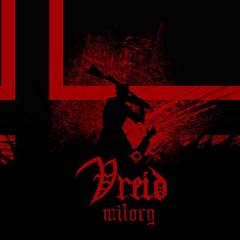 Black metal was about writing unique melodies and building song structures to fit them. Vreid is about mimicking the past with more intensity in each riff, but relying on predictable melodic strips and linear song structures in circular repetition, resulting in songs that are binary like nu-metal: a softer part, then a harder part, then a response to that which softens the hardness, then a restatement at full blast, fade out and win. Most of these riffs come from the 1970s and 1980s generations of metal and get a “black metal” treatment, so end up sounding like rock music in its Sunday black metal evil clothes. The music is driving by a chanting vocal which rides the beat like the shouts of the drummer commanding the slaves to row. Every now and then they launch into an extended melody like a pentatonic version of early ancient, and they have the raw rhythmic power of an early Marduk or Zyklon, but it doesn’t add up to more than most rock music, and considerably less than the formative works of Nordic black metal.
Black metal was about writing unique melodies and building song structures to fit them. Vreid is about mimicking the past with more intensity in each riff, but relying on predictable melodic strips and linear song structures in circular repetition, resulting in songs that are binary like nu-metal: a softer part, then a harder part, then a response to that which softens the hardness, then a restatement at full blast, fade out and win. Most of these riffs come from the 1970s and 1980s generations of metal and get a “black metal” treatment, so end up sounding like rock music in its Sunday black metal evil clothes. The music is driving by a chanting vocal which rides the beat like the shouts of the drummer commanding the slaves to row. Every now and then they launch into an extended melody like a pentatonic version of early ancient, and they have the raw rhythmic power of an early Marduk or Zyklon, but it doesn’t add up to more than most rock music, and considerably less than the formative works of Nordic black metal.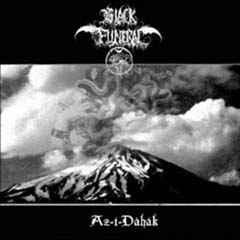 Throbbing notes rhythm a rhythm that then reverses, examines a portion of itself in detail, and then picks up in a new direction which dovetails with the old; the throb remains, like symbols etched in the air with a torch caught on the slower memory of film. In this way, Black Funeral achieves an odd ambience similar to that of Impetigo, where a higher note is strummed repetitively at an offset rhythm where most bands would hammer a lower note on the beat, but by the nature of the larger melodic structure of the riff, this throb does not bounce jauntily like a rock rhythm; it hangs, like a reminder of mortality. Vocals are chant-ish black metal rasps and the mechanistic pedaling of the drum machine fits this sound like a glove, getting further inhuman as it distances us from musical expectation and clean aesthetics. Like the humming beeps of an alien machine exploring the night, this album rediscovers humanity by removing it from the picture and showing us the empty space in which we must construct as inevitable death closes in. While most experts agree “Vampyr” is the height of this band — and who am I to disagree? — this perhaps less proficient album is more haunting and bizarre, yet fits it into a pattern similar to our reminiscences of isolated nights when the future angled away from us like the shadow of an unknown doorway.
Throbbing notes rhythm a rhythm that then reverses, examines a portion of itself in detail, and then picks up in a new direction which dovetails with the old; the throb remains, like symbols etched in the air with a torch caught on the slower memory of film. In this way, Black Funeral achieves an odd ambience similar to that of Impetigo, where a higher note is strummed repetitively at an offset rhythm where most bands would hammer a lower note on the beat, but by the nature of the larger melodic structure of the riff, this throb does not bounce jauntily like a rock rhythm; it hangs, like a reminder of mortality. Vocals are chant-ish black metal rasps and the mechanistic pedaling of the drum machine fits this sound like a glove, getting further inhuman as it distances us from musical expectation and clean aesthetics. Like the humming beeps of an alien machine exploring the night, this album rediscovers humanity by removing it from the picture and showing us the empty space in which we must construct as inevitable death closes in. While most experts agree “Vampyr” is the height of this band — and who am I to disagree? — this perhaps less proficient album is more haunting and bizarre, yet fits it into a pattern similar to our reminiscences of isolated nights when the future angled away from us like the shadow of an unknown doorway.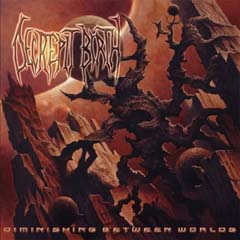 If the recombinant album name and band name didn’t clue you in, here’s the skinny: this band is totally postmodern, meaning that they fit together all sorts of random influences and then link them together with the basics of rhythm and harmony. As a result, it’s like a fast ride at Disneyland: constant changing stimulus of radical difference so much that after a while you lose any idea of where you are, and end up thinking you’ve come very far, when at the very end as the buggy slows you realize you’ve been circling around the same relatively small space. Unlike most bands of this type, which I’m going to call crypto-metalcore because it’s (a) without death metal’s style of organization, preferring instead the hardcore method of having riffs have as little in common as possible and no narrative (b) of mixed riff styles and (c) depends on rhythmic buildup/breakdown for tension because you’re not going to get it in contrast between riffs, Decrepit Birth is good — it’s like an Iron Maiden album hidden in Deeds of Flesh with Blotted Science and Negativa offering critique. However, I can’t listen to this carnival music; it breaks down concentration and replaces it with elaborate versions of territory trod long ago.
If the recombinant album name and band name didn’t clue you in, here’s the skinny: this band is totally postmodern, meaning that they fit together all sorts of random influences and then link them together with the basics of rhythm and harmony. As a result, it’s like a fast ride at Disneyland: constant changing stimulus of radical difference so much that after a while you lose any idea of where you are, and end up thinking you’ve come very far, when at the very end as the buggy slows you realize you’ve been circling around the same relatively small space. Unlike most bands of this type, which I’m going to call crypto-metalcore because it’s (a) without death metal’s style of organization, preferring instead the hardcore method of having riffs have as little in common as possible and no narrative (b) of mixed riff styles and (c) depends on rhythmic buildup/breakdown for tension because you’re not going to get it in contrast between riffs, Decrepit Birth is good — it’s like an Iron Maiden album hidden in Deeds of Flesh with Blotted Science and Negativa offering critique. However, I can’t listen to this carnival music; it breaks down concentration and replaces it with elaborate versions of territory trod long ago.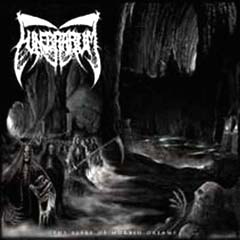 What happened here? Eight years ago — before old-school “revival” was even a blip on the radar — this band had the apparent potential to give proper life to archaic death metal form. Their first album/demo was a brooding, infectious and grimly cohesive piece of work, enough so to make this sound almost brazenly cheap by comparison. Toss in every imaginable death metal riff style coined between 1989 and 1993, lay them out on a rhythmic smorgasbord and put them through enough mood changes to make a pregnant teenager blush and you’ve come damn close to this; add enough embarassing Bloodbath-sounding material (listen to the opener) to something otherwise “authentic” and you’ll never want to hear “old school” again. – kontinual
What happened here? Eight years ago — before old-school “revival” was even a blip on the radar — this band had the apparent potential to give proper life to archaic death metal form. Their first album/demo was a brooding, infectious and grimly cohesive piece of work, enough so to make this sound almost brazenly cheap by comparison. Toss in every imaginable death metal riff style coined between 1989 and 1993, lay them out on a rhythmic smorgasbord and put them through enough mood changes to make a pregnant teenager blush and you’ve come damn close to this; add enough embarassing Bloodbath-sounding material (listen to the opener) to something otherwise “authentic” and you’ll never want to hear “old school” again. – kontinual There are some of us who believe that rock and roll music, instead of being a thing deliberately created, is an aggregate of what was left over when we tested everything else against a captive audience. Star Fucking Hipsters prove this by carefully absorbing everything they can into the great sponge of melancholy indie pop. These songs usually start off with fast punk or speed metal (Slayer) riffs, and then pass through a few exciting transitions borrowed from anything industrial, black and reggage or between, but then we get to the core: darkish, self-pitying, somewhat helpless indie pop. True, it’s in pop punk format like The Descendents meets Blink 182 with Jane’s Addiction advising on behalf of the emo CIA, but basically, it’s pop. And when we get to that point we see this album is like a confused and lonely person in the city, covering themselves with newspapers or whatever fashions they can yank out of the wind, hoping no one will ever get a glimpse inside. If that’s its goal, this is supreme art, but more likely it is the emoting of such people hoping we’ll justify their existence for them. As pop, it’s not bad, a little toward the “poignant” side of minor key melodies sliding into major key to give you a sense of hope. But it’s really the same old thing, or the latest incarnation of it in whatever styles have stuck over the past twelve years, and so I can’t imagine why you’d listen to this instead of any of the 100,000 other albums this “good” in the rock style.
There are some of us who believe that rock and roll music, instead of being a thing deliberately created, is an aggregate of what was left over when we tested everything else against a captive audience. Star Fucking Hipsters prove this by carefully absorbing everything they can into the great sponge of melancholy indie pop. These songs usually start off with fast punk or speed metal (Slayer) riffs, and then pass through a few exciting transitions borrowed from anything industrial, black and reggage or between, but then we get to the core: darkish, self-pitying, somewhat helpless indie pop. True, it’s in pop punk format like The Descendents meets Blink 182 with Jane’s Addiction advising on behalf of the emo CIA, but basically, it’s pop. And when we get to that point we see this album is like a confused and lonely person in the city, covering themselves with newspapers or whatever fashions they can yank out of the wind, hoping no one will ever get a glimpse inside. If that’s its goal, this is supreme art, but more likely it is the emoting of such people hoping we’ll justify their existence for them. As pop, it’s not bad, a little toward the “poignant” side of minor key melodies sliding into major key to give you a sense of hope. But it’s really the same old thing, or the latest incarnation of it in whatever styles have stuck over the past twelve years, and so I can’t imagine why you’d listen to this instead of any of the 100,000 other albums this “good” in the rock style.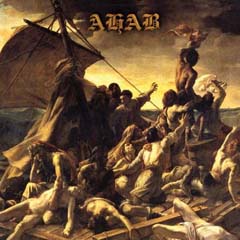 Funeral doom of a style similar to Skepticism if merged with Esoteric, with a tiny bit of Paradise Lost or Sleep in the wings, Ahab is a studied take on the slow and depressive atmospheric music that many people seem to enjoy. Stylistically, it is probably the most advanced of its kind; musically, it is perfectly competent; artistically, it is not particularly compelling. Its melodies have less of a sense of mixed emotions than do those of Skepticism, and its songs develop in predictable cycles within cycles, leaving us with atmosphere by default once all else has been blocked out. Like American rock bands, Ahab also has to throw in that sense of “contrast” where any dominant idea gets a contrarian voice thrown up against it, where bands like Skepticism bear down with enhancement and variation inside their major ideas. Few want to be the voice to stand up and say this, but most doom metal is boring, and not just because it’s slow. Ahab, while better than most, falls under this umbrella.
Funeral doom of a style similar to Skepticism if merged with Esoteric, with a tiny bit of Paradise Lost or Sleep in the wings, Ahab is a studied take on the slow and depressive atmospheric music that many people seem to enjoy. Stylistically, it is probably the most advanced of its kind; musically, it is perfectly competent; artistically, it is not particularly compelling. Its melodies have less of a sense of mixed emotions than do those of Skepticism, and its songs develop in predictable cycles within cycles, leaving us with atmosphere by default once all else has been blocked out. Like American rock bands, Ahab also has to throw in that sense of “contrast” where any dominant idea gets a contrarian voice thrown up against it, where bands like Skepticism bear down with enhancement and variation inside their major ideas. Few want to be the voice to stand up and say this, but most doom metal is boring, and not just because it’s slow. Ahab, while better than most, falls under this umbrella.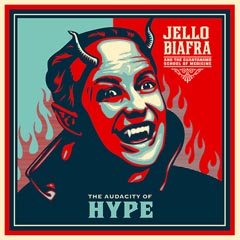 Purists will kill me for this, but this is Biafra’s best work — it’s musical. Where the Dead Kennedys sounded disorganized and messy without really building on that as an aesthetic, he’s slowed down to a pop-punk combo that uses hardcore riffs (Discharge, Exploited) to balance its melodic lead picking (Circle Jerks, The Plugz). That, plus Southern Fried guitar solos and lead guitar noise, forms the underpinning for a more interesting Biafra performance than has ever been heard before. On this CD, Biafra develops his vocal lines both melodically and in timbre, giving the performance of his life with verve and energy. You’ve heard these riff types before, and many of the note progressions are “pop culture” stalwarts that show up in movie soundtracks and commercials, but here Biafra and his band develop each into a song that’s half-rock and half-hardcore, creating a foundation that will introduce a new generation to the sounds of hardcore punk.
Purists will kill me for this, but this is Biafra’s best work — it’s musical. Where the Dead Kennedys sounded disorganized and messy without really building on that as an aesthetic, he’s slowed down to a pop-punk combo that uses hardcore riffs (Discharge, Exploited) to balance its melodic lead picking (Circle Jerks, The Plugz). That, plus Southern Fried guitar solos and lead guitar noise, forms the underpinning for a more interesting Biafra performance than has ever been heard before. On this CD, Biafra develops his vocal lines both melodically and in timbre, giving the performance of his life with verve and energy. You’ve heard these riff types before, and many of the note progressions are “pop culture” stalwarts that show up in movie soundtracks and commercials, but here Biafra and his band develop each into a song that’s half-rock and half-hardcore, creating a foundation that will introduce a new generation to the sounds of hardcore punk.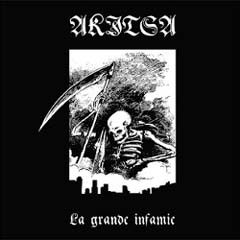 Most of us love the idea of black metal: a few totally socially alienated people, armed only with the truth, pick up guitars one weekend and make a simple mind-virus that helps slay all of the vastly powerful illusions that make our modern world miserable. The problem is that this is far from the truth: most of the people who have made great simple black metal were expert players or at least savants who self-schooled themselves in a unique and powerful style, and their work is very deliberate and designed to make us enjoy life as much as convey some idea. But as in all things, each generation picks up where the previous generation appeared to leave off, so the source of the idea is always lost. Akitsa sounds like a cross between The Exploited and early Dark Funeral, with simple melodic riffs offset against sawing basic power chording; the melodic riffs are too candy-sweet and the power chord riffs are too much of a style we can get anywhere. “Silence” appears to be heavily influenced by “Thy Winter Kingdom” from the first Behemoth CD. The rest of the CD is alternating Burzum influences with later model droning melody. It is both not bad and not really compelling enough to want to hear again.
Most of us love the idea of black metal: a few totally socially alienated people, armed only with the truth, pick up guitars one weekend and make a simple mind-virus that helps slay all of the vastly powerful illusions that make our modern world miserable. The problem is that this is far from the truth: most of the people who have made great simple black metal were expert players or at least savants who self-schooled themselves in a unique and powerful style, and their work is very deliberate and designed to make us enjoy life as much as convey some idea. But as in all things, each generation picks up where the previous generation appeared to leave off, so the source of the idea is always lost. Akitsa sounds like a cross between The Exploited and early Dark Funeral, with simple melodic riffs offset against sawing basic power chording; the melodic riffs are too candy-sweet and the power chord riffs are too much of a style we can get anywhere. “Silence” appears to be heavily influenced by “Thy Winter Kingdom” from the first Behemoth CD. The rest of the CD is alternating Burzum influences with later model droning melody. It is both not bad and not really compelling enough to want to hear again.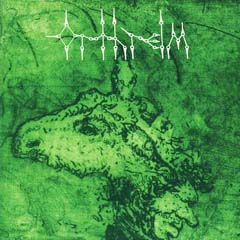 I wish this album were a joke, but like most modern and postmodern art, it’s an attempt to “demonstrate” an “idea,” and that idea has no correlation to the reality of an artist both entertaining and informing his listeners. Instead, you get a lot of fast chromatic playing over serial drumming with occasional breaks into jazz-style breakdowns that are either sloppy or misinformed about music theory. The result is a dissonant atmosphere after the band lulls you into contentment with repetition. Over time, the basic pattern increases in a period-doubling format, creating a linear expansion on a basic idea that resembles holy books that write about the universe expanding from a breath, except here the expansion leads to nothing but a reflection of itself. When Burzum did this with Det Som Engang Var, it built a mood that gained resurgent power of time; here it is purely deconstructive and fragments the listener’s attention span by forcing it through a narrow slit of musical awareness. People will like this because it’s unique, and talk about how genius it is because no one else “dared to be different” to such a degree, but as a work of meaningful art and a listening experience, it is worthless.
I wish this album were a joke, but like most modern and postmodern art, it’s an attempt to “demonstrate” an “idea,” and that idea has no correlation to the reality of an artist both entertaining and informing his listeners. Instead, you get a lot of fast chromatic playing over serial drumming with occasional breaks into jazz-style breakdowns that are either sloppy or misinformed about music theory. The result is a dissonant atmosphere after the band lulls you into contentment with repetition. Over time, the basic pattern increases in a period-doubling format, creating a linear expansion on a basic idea that resembles holy books that write about the universe expanding from a breath, except here the expansion leads to nothing but a reflection of itself. When Burzum did this with Det Som Engang Var, it built a mood that gained resurgent power of time; here it is purely deconstructive and fragments the listener’s attention span by forcing it through a narrow slit of musical awareness. People will like this because it’s unique, and talk about how genius it is because no one else “dared to be different” to such a degree, but as a work of meaningful art and a listening experience, it is worthless.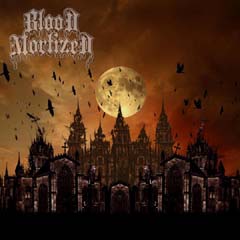 This band claims “active” status in the early nineties, with zero material to show for it. It may very well be true; current personnel have some of the more run-of-the-mill Stockholm bands to brag about in their ancestry. Excited yet? This falls somewhere between Amon Amarth and Dismember’s Massive Killing Capacity, smothered in the “soft” mimicry of the Sunlight sound that seems so common for these fence-sitting bands. The plod is painful and simple and the song development as bluntly screwball as the song titles, lending an air of crafted irony to the whole presentation lest somebody seriously stack it up against any of its predecessors. One wonders whence this stuff keeps coming — I’m wont to call this the “Swedish mid-life crisis” and leave it at that. – kontinual
This band claims “active” status in the early nineties, with zero material to show for it. It may very well be true; current personnel have some of the more run-of-the-mill Stockholm bands to brag about in their ancestry. Excited yet? This falls somewhere between Amon Amarth and Dismember’s Massive Killing Capacity, smothered in the “soft” mimicry of the Sunlight sound that seems so common for these fence-sitting bands. The plod is painful and simple and the song development as bluntly screwball as the song titles, lending an air of crafted irony to the whole presentation lest somebody seriously stack it up against any of its predecessors. One wonders whence this stuff keeps coming — I’m wont to call this the “Swedish mid-life crisis” and leave it at that. – kontinual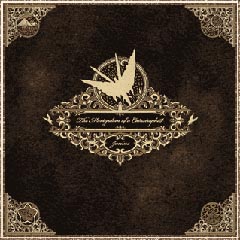 What is post-rock? For most, it’s slow atmospheric rock beats with emo, punk, indie and noise riffs slowed down to provide texture. On this CD, Junius blend in a modern taste of the ancient with a Dead Can Dance influence. The result is like a river, winding around obstacles to rejoin itself, but only suggesting a topography. This music is comforting and melancholic, but not really exciting. It is pretty, but will find it hard to escape a lukewarm rock underpinning that reigns in its tendencies to escape for the outer limits. A reasonable comparison might be if Danzig decided to do a space rock album: you can appreciate it aesthetically, but sense how the voice isn’t really there, and how as much as these guys want to be ancient, they’re stuck in a modern paradigm.
What is post-rock? For most, it’s slow atmospheric rock beats with emo, punk, indie and noise riffs slowed down to provide texture. On this CD, Junius blend in a modern taste of the ancient with a Dead Can Dance influence. The result is like a river, winding around obstacles to rejoin itself, but only suggesting a topography. This music is comforting and melancholic, but not really exciting. It is pretty, but will find it hard to escape a lukewarm rock underpinning that reigns in its tendencies to escape for the outer limits. A reasonable comparison might be if Danzig decided to do a space rock album: you can appreciate it aesthetically, but sense how the voice isn’t really there, and how as much as these guys want to be ancient, they’re stuck in a modern paradigm.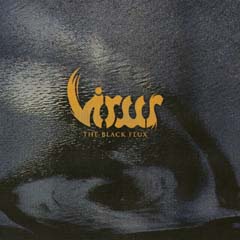 For the last time: if I wanted indie rock, I would have gone to a different part of the record store. Take your Sisters of Mercy gothic vocals, your bad indie rock open chord guitar riffs, and your basic song structures interrupted by dramatic outbursts, and put them there. I don’t want to fall into the old trap of saying “this isn’t metal,” because what I really want to say is that this is indie rock and should be integrated into that genre for the modicum of black metal stylings and ideas it still possesses. Sure, they’re going to call it a “post-rock” influence, but other than a little flexibility of rhythm, what’s going on here is the same stuff emo, indie and shoegaze bands were pumping out in the early 1990s.
For the last time: if I wanted indie rock, I would have gone to a different part of the record store. Take your Sisters of Mercy gothic vocals, your bad indie rock open chord guitar riffs, and your basic song structures interrupted by dramatic outbursts, and put them there. I don’t want to fall into the old trap of saying “this isn’t metal,” because what I really want to say is that this is indie rock and should be integrated into that genre for the modicum of black metal stylings and ideas it still possesses. Sure, they’re going to call it a “post-rock” influence, but other than a little flexibility of rhythm, what’s going on here is the same stuff emo, indie and shoegaze bands were pumping out in the early 1990s.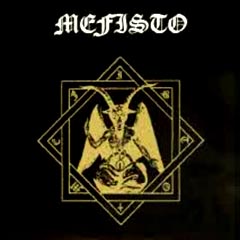 This CD resembles death metal in no way other than the vocals, which are the kind of reverbed whisper shout that made the first Sepultura EP so memorable. But the music… well, it’s stranded in the 1980s. Throw a lot of Metallica, Kreator, Slayer and Destruction in a blender — like every other band from that era — and you’ll get this mismash of riffs very similar to both the aforementioned bands and a huge heritage of heavy metal. To their credit, this band string them together well rhythmically but otherwise seem entirely random. Before someone convinces you this is a forgotten classic, ask them if classic means “good” or just that it was around in the early 1990s.
This CD resembles death metal in no way other than the vocals, which are the kind of reverbed whisper shout that made the first Sepultura EP so memorable. But the music… well, it’s stranded in the 1980s. Throw a lot of Metallica, Kreator, Slayer and Destruction in a blender — like every other band from that era — and you’ll get this mismash of riffs very similar to both the aforementioned bands and a huge heritage of heavy metal. To their credit, this band string them together well rhythmically but otherwise seem entirely random. Before someone convinces you this is a forgotten classic, ask them if classic means “good” or just that it was around in the early 1990s. We all want to love anything with the enigmatic Nocturno Culto on it. In fact, many of us were hoping he would pull off a Nemesis Divina where his skills converted an unexceptional band into a relative masterpiece. Not so on Sarke — his performance is phoned in, mainly because these songs are sparse, undeveloped, and entirely derivative of their influences in a 1989 way. In fact, the whole CD has the vibe of a collection of songs that have been kicked around since they got written in the 1980s, finally put onto vinyl years after the genre has passed them by. You’re familiar with these chord progressions and general rhythms, since many of them come out of punk rock and hard rock, and you’re probably not unacquainted — unless you’ve been under a rock labeled BLACK METAL GO HOME for the last two decades — with Culto’s interpretation of them. It’s all quite vanilla; nothing to really be appalled at here except how little you care about this flat regurgitation of the past.
We all want to love anything with the enigmatic Nocturno Culto on it. In fact, many of us were hoping he would pull off a Nemesis Divina where his skills converted an unexceptional band into a relative masterpiece. Not so on Sarke — his performance is phoned in, mainly because these songs are sparse, undeveloped, and entirely derivative of their influences in a 1989 way. In fact, the whole CD has the vibe of a collection of songs that have been kicked around since they got written in the 1980s, finally put onto vinyl years after the genre has passed them by. You’re familiar with these chord progressions and general rhythms, since many of them come out of punk rock and hard rock, and you’re probably not unacquainted — unless you’ve been under a rock labeled BLACK METAL GO HOME for the last two decades — with Culto’s interpretation of them. It’s all quite vanilla; nothing to really be appalled at here except how little you care about this flat regurgitation of the past.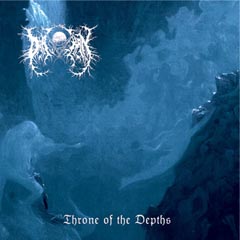 We live in a time of fools. Given no real truths to chew on, they raise themselves on lies, and make competing lies so they can be heard. Then they tell us what metal bands to listen to, and they cannot tell the difference between good music and derivative shit. They will, for example, convince themselves that Drautran is folk metal, when really it’s indie rock songs dressed up in black metal chord forms with a little extra violence. Unlike metal songs, where riffs fit together and make sense, these are rock songs with some metal riffs dropped in between the sing-song verse chorus. They take their riffing inspiration from Enslaved’s Frost but none of the compositional coherence is here. Listen to this if you want to distract yourself, fragment your concentration and dull your possibilities of ever understanding the difference between good music and crap.
We live in a time of fools. Given no real truths to chew on, they raise themselves on lies, and make competing lies so they can be heard. Then they tell us what metal bands to listen to, and they cannot tell the difference between good music and derivative shit. They will, for example, convince themselves that Drautran is folk metal, when really it’s indie rock songs dressed up in black metal chord forms with a little extra violence. Unlike metal songs, where riffs fit together and make sense, these are rock songs with some metal riffs dropped in between the sing-song verse chorus. They take their riffing inspiration from Enslaved’s Frost but none of the compositional coherence is here. Listen to this if you want to distract yourself, fragment your concentration and dull your possibilities of ever understanding the difference between good music and crap.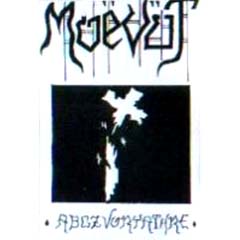 Every now and then, people who lack direction in life and so pay attention to surface features more than anything else, hoping to use these to justify their emptiness, will try to tell you how good a band is because it’s unique and nuanced. Usually this includes some kind of infantilism, like extreme minimalism or incoherence. This tedious little recording fits the bill. People like it because it’s obscure, kvlt, whatever… the truth is that it’s melodically simplistic, goes nowhere in song development, and showcases no really unique ability except to waste your time. They try to eat up as much tape as possible with intros, chants, and very basic keyboard melodies, but basically there’s nothing here. Maybe that’s the artistic point — emptiness — but then again a blank tape would have been more effective, and pleasant.
Every now and then, people who lack direction in life and so pay attention to surface features more than anything else, hoping to use these to justify their emptiness, will try to tell you how good a band is because it’s unique and nuanced. Usually this includes some kind of infantilism, like extreme minimalism or incoherence. This tedious little recording fits the bill. People like it because it’s obscure, kvlt, whatever… the truth is that it’s melodically simplistic, goes nowhere in song development, and showcases no really unique ability except to waste your time. They try to eat up as much tape as possible with intros, chants, and very basic keyboard melodies, but basically there’s nothing here. Maybe that’s the artistic point — emptiness — but then again a blank tape would have been more effective, and pleasant.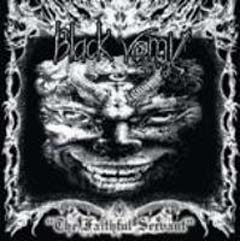 Interesting approach by this Mexican band: take a more technical version of the full speed burst style semi-melodic black metal that Sarcofago made, and intersperse it with flowing keyboard-enhanced choruses in the style of countrymen Xibalba and Avzhia. The result suffers from the radical shift between two very identifiable poles, but the music although very basic develops gently through this style, and as a result is more credible than most of what we get sent here at the Dark Legions Archive Metal Reviews and CD Recycling Center. This is a band worth keeping an eye on.
Interesting approach by this Mexican band: take a more technical version of the full speed burst style semi-melodic black metal that Sarcofago made, and intersperse it with flowing keyboard-enhanced choruses in the style of countrymen Xibalba and Avzhia. The result suffers from the radical shift between two very identifiable poles, but the music although very basic develops gently through this style, and as a result is more credible than most of what we get sent here at the Dark Legions Archive Metal Reviews and CD Recycling Center. This is a band worth keeping an eye on.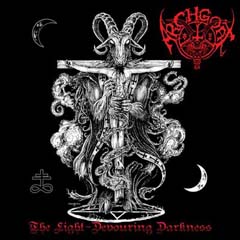 I’m convinced that a lot of contemporary death and black metal is music designed for children, because not only is it painfully simple and repetitive, but it also uses gentle rhythms of chord change — while playing at top speed. It’s like listening to a fan slowly playing an early Mozart piece. This album is similar. Sounds a lot like Blasphemy meets Impaled Nazarene, with the lower register production and slamming tempo changes of Belial. So as a retrospective of Finnish metal technique it’s great, but for anything else, it’s kind of a droning lullaby. What excuses it is that this CD shows purpose in its songwriting, and captures a mood, but for many of us the droning outweighs its significance.
I’m convinced that a lot of contemporary death and black metal is music designed for children, because not only is it painfully simple and repetitive, but it also uses gentle rhythms of chord change — while playing at top speed. It’s like listening to a fan slowly playing an early Mozart piece. This album is similar. Sounds a lot like Blasphemy meets Impaled Nazarene, with the lower register production and slamming tempo changes of Belial. So as a retrospective of Finnish metal technique it’s great, but for anything else, it’s kind of a droning lullaby. What excuses it is that this CD shows purpose in its songwriting, and captures a mood, but for many of us the droning outweighs its significance.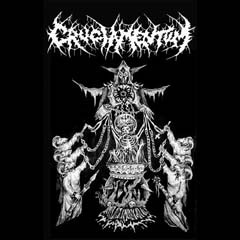 During the past two years, underground black metal shifted from emulating the early 1990s — fast melody — to emulating the late 1990s, specifically Demoncy’s “Joined in Darkness.” The Convocation EP does its best to revive that sound, with an injection of Finnish death metal and possibly American doom/death like Incantation, Winter and Infester. Although it keeps its goals limited, which is appropriate for a demo, this release shows promise in songwriting in that (a) every piece works together (b) together they create a vision of some idea, experience or emotion we can recognize from life itself and (c) while a good deal of it covers known death metal archetypes, it does so without borrowing straight from one source and so gives us a sense of exploring these ideas from a new angle. Low rasp voices, downtuned rigid guitars, and drumming that sounds like it’s straight out of drone/hardcore punk fusion gives this CD a sense of growing out of the past toward something even more ancient.
During the past two years, underground black metal shifted from emulating the early 1990s — fast melody — to emulating the late 1990s, specifically Demoncy’s “Joined in Darkness.” The Convocation EP does its best to revive that sound, with an injection of Finnish death metal and possibly American doom/death like Incantation, Winter and Infester. Although it keeps its goals limited, which is appropriate for a demo, this release shows promise in songwriting in that (a) every piece works together (b) together they create a vision of some idea, experience or emotion we can recognize from life itself and (c) while a good deal of it covers known death metal archetypes, it does so without borrowing straight from one source and so gives us a sense of exploring these ideas from a new angle. Low rasp voices, downtuned rigid guitars, and drumming that sounds like it’s straight out of drone/hardcore punk fusion gives this CD a sense of growing out of the past toward something even more ancient.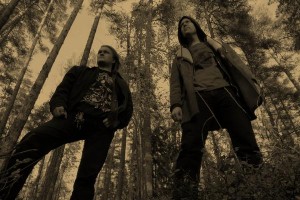 1.
1. 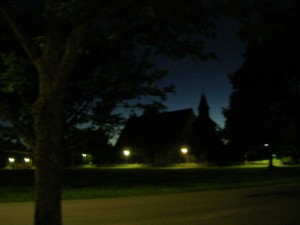
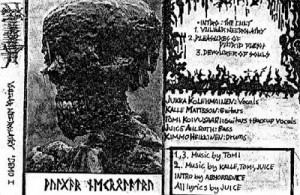 Out of the silence and the cold of wintry nights arose wolven howls, bestial growls and the electric screech of demoniac strings. Clandestine groups scattered across the lake-adorned strip of land which was too vast in area for the people to be in constant touch except by phone and letter, took to the newest musical movement to inherit the throne of the kings of headbanging and thrash: grindcore. Xysma from Turku played Carcass inspired devolved bursts of groovy noise with the mechanical straightforward approach upon which Finnish industrial corporations later built their reputation.
Out of the silence and the cold of wintry nights arose wolven howls, bestial growls and the electric screech of demoniac strings. Clandestine groups scattered across the lake-adorned strip of land which was too vast in area for the people to be in constant touch except by phone and letter, took to the newest musical movement to inherit the throne of the kings of headbanging and thrash: grindcore. Xysma from Turku played Carcass inspired devolved bursts of groovy noise with the mechanical straightforward approach upon which Finnish industrial corporations later built their reputation.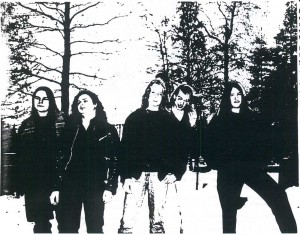 Jalas: I can agree on that this was the strongest period for the music and most of it died in the mid 1990′s when Black Metal music “took over” the underground. For me it is still a bit hard to analyze all this. I have always listened to what I want and when I want. I’m not saying that I didn’t have Black Metal seasons, but bands like Slayer and Morbid Angel were always there, lurking behind (both in my record player and as recording artists).
Jalas: I can agree on that this was the strongest period for the music and most of it died in the mid 1990′s when Black Metal music “took over” the underground. For me it is still a bit hard to analyze all this. I have always listened to what I want and when I want. I’m not saying that I didn’t have Black Metal seasons, but bands like Slayer and Morbid Angel were always there, lurking behind (both in my record player and as recording artists).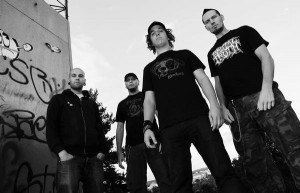 Not many of the original Death Metal fans were enthusiastic about Children of Bodom’s sappy power metal infiltration of Gothenburg techniques or Rotten Sound’s mechanical drum clinic grindcore. Nevertheless, the next generation of longhairs were inspired by these bands who had mastered the latest techniques of production perfect for a violently loud catharsis in car stereo or as a video game soundtrack. It was escapist, but not the Yuggothian dreams of a Demigod. In this case, influenced by groove metal and speed metal, commercial Death Metal sought to act as a youth counselor, harnessing hate and psychotic religion into the individualism of I don’t give a fuck and the various related ethical systems of liberalism.
Not many of the original Death Metal fans were enthusiastic about Children of Bodom’s sappy power metal infiltration of Gothenburg techniques or Rotten Sound’s mechanical drum clinic grindcore. Nevertheless, the next generation of longhairs were inspired by these bands who had mastered the latest techniques of production perfect for a violently loud catharsis in car stereo or as a video game soundtrack. It was escapist, but not the Yuggothian dreams of a Demigod. In this case, influenced by groove metal and speed metal, commercial Death Metal sought to act as a youth counselor, harnessing hate and psychotic religion into the individualism of I don’t give a fuck and the various related ethical systems of liberalism.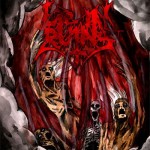 The veteran Death Metallers from Olari practiced and mastered their Scandinavia influenced art for 15 years before their first release on a label, the impressive “Architecture of the Dead” EP featuring older compositions. While this unique band seemed to receive very little promotion, disciples prayed for the day of reckoning when this constellation could bestow their malevolence in full force upon the wretched scene. The long, exhausting spell “Swallowed by the Void” was to be the definitive answer to these inquiries. Sluggish, conjuring and micro-melodic abyss anthems pay unyielding tribute to the likes of Dismember and Grotesque, aiming for an evil glory that betrays the way death metal lost the innocent meddling in dark arts prevalent in the late 80’s and discovered serious ideologies by the force of contamination and crossbreeding with Black Metal. Especially the progressive moods of the deadly closing track “Bringer of Desolation”, reminiscent of the Lovecraftian horror pathos of the longer tracks by Nile deserves an inclusion in the Death Metal canon of the decade. Serious catacomb dwelling fans of Repugnant and Necros Christos will feel completely at home with Lie in Ruins’ atmospheric, sacral method of composition which eschews fast and classical parts, but returns to the Sabbath-ian roots of primal death doom experience.
The veteran Death Metallers from Olari practiced and mastered their Scandinavia influenced art for 15 years before their first release on a label, the impressive “Architecture of the Dead” EP featuring older compositions. While this unique band seemed to receive very little promotion, disciples prayed for the day of reckoning when this constellation could bestow their malevolence in full force upon the wretched scene. The long, exhausting spell “Swallowed by the Void” was to be the definitive answer to these inquiries. Sluggish, conjuring and micro-melodic abyss anthems pay unyielding tribute to the likes of Dismember and Grotesque, aiming for an evil glory that betrays the way death metal lost the innocent meddling in dark arts prevalent in the late 80’s and discovered serious ideologies by the force of contamination and crossbreeding with Black Metal. Especially the progressive moods of the deadly closing track “Bringer of Desolation”, reminiscent of the Lovecraftian horror pathos of the longer tracks by Nile deserves an inclusion in the Death Metal canon of the decade. Serious catacomb dwelling fans of Repugnant and Necros Christos will feel completely at home with Lie in Ruins’ atmospheric, sacral method of composition which eschews fast and classical parts, but returns to the Sabbath-ian roots of primal death doom experience.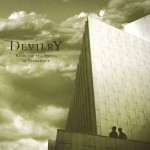 One of the most anti-social and least compromising commando squads from Finland in any musical genre, Devilry’s series of EP’s cumulated during the decade into an impressive demonstration of technical and lyrical ability that converted hordes of Black Metal listeners into old school Death Metal and vicious thrash. Like a less confused “The Laws of Scourge” era Sarcofago, Devilry abstains from long buildups to frame scenes of street violence and political upheaval in robotically symmetric percussion and inhuman, precise, spouting syllables of learned rhetoric. One of the fastest Finnish metal bands, at least in overall impression, Devilry quotes Slayer for a reductionist but holistic approach to songwriting which means that each song is built from a clearly defined set of riffs arranged to unleash the most powerful experience of intensity on the listener, while Sir Holm’s text praises the law and order of a reich that would be built according to the code of the warrior and rule of the naturally supreme. Essays could be written about Devilry’s interest in beauty, as despite the feral character of the music all songs are geometrical complexes with no loose parts hanging and even the cover picture is a serene, celestial scene incorporating Finnish functionalist architecture. Even the condemnation and hate that hangs as an eternal cloud upon the political rants of Devilry, are mostly posed as arguments of: what is not beautiful, does not deserve to be upheld, not even tolerated.
One of the most anti-social and least compromising commando squads from Finland in any musical genre, Devilry’s series of EP’s cumulated during the decade into an impressive demonstration of technical and lyrical ability that converted hordes of Black Metal listeners into old school Death Metal and vicious thrash. Like a less confused “The Laws of Scourge” era Sarcofago, Devilry abstains from long buildups to frame scenes of street violence and political upheaval in robotically symmetric percussion and inhuman, precise, spouting syllables of learned rhetoric. One of the fastest Finnish metal bands, at least in overall impression, Devilry quotes Slayer for a reductionist but holistic approach to songwriting which means that each song is built from a clearly defined set of riffs arranged to unleash the most powerful experience of intensity on the listener, while Sir Holm’s text praises the law and order of a reich that would be built according to the code of the warrior and rule of the naturally supreme. Essays could be written about Devilry’s interest in beauty, as despite the feral character of the music all songs are geometrical complexes with no loose parts hanging and even the cover picture is a serene, celestial scene incorporating Finnish functionalist architecture. Even the condemnation and hate that hangs as an eternal cloud upon the political rants of Devilry, are mostly posed as arguments of: what is not beautiful, does not deserve to be upheld, not even tolerated.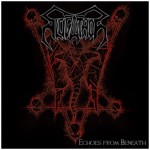 Slugathor is already a veteran of “new” Finnish Death Metal, having debuted in 2000 with the “Delicacies of the Cadaver” EP right when everyone else was concentrating in elitist Black Metal fantasies. The morbid, dirty, ugly and non-theatrical submersion to grinding but dimensional grave exhumations was initially scorned upon but eventually they even signed to one of the premier Black Metal labels of the world, Drakkar Records from France. By the time of the third album “Echoes from Beneath” Slugathor knows exactly how to manipulate intensity and the listening experience of both black and Death Metal listeners, opening cavernous vaults and passages through warped holes in time and space using mostly foreboding rhythm guitar chugging of patterns familiar from since the dawn of Death Metal, ethereal melodic background leads by Tommi Grönqvist and evil vocals by Axu Laakso that borrow technique from both Deicide and Demilich without sounding as extreme as them. Like Bolt Thrower, this band is all about heaviness, ambience and symmetry while all “display” type of elements of technical Death Metal are kept to a minimum. A special mention goes to Ilmari Jalas’ drum technique which borrows heavily from Doom Metal in building up groove to a climax where dynamics emphasize the rhythm riff so that the only possibility is to headbang convulsively.
Slugathor is already a veteran of “new” Finnish Death Metal, having debuted in 2000 with the “Delicacies of the Cadaver” EP right when everyone else was concentrating in elitist Black Metal fantasies. The morbid, dirty, ugly and non-theatrical submersion to grinding but dimensional grave exhumations was initially scorned upon but eventually they even signed to one of the premier Black Metal labels of the world, Drakkar Records from France. By the time of the third album “Echoes from Beneath” Slugathor knows exactly how to manipulate intensity and the listening experience of both black and Death Metal listeners, opening cavernous vaults and passages through warped holes in time and space using mostly foreboding rhythm guitar chugging of patterns familiar from since the dawn of Death Metal, ethereal melodic background leads by Tommi Grönqvist and evil vocals by Axu Laakso that borrow technique from both Deicide and Demilich without sounding as extreme as them. Like Bolt Thrower, this band is all about heaviness, ambience and symmetry while all “display” type of elements of technical Death Metal are kept to a minimum. A special mention goes to Ilmari Jalas’ drum technique which borrows heavily from Doom Metal in building up groove to a climax where dynamics emphasize the rhythm riff so that the only possibility is to headbang convulsively.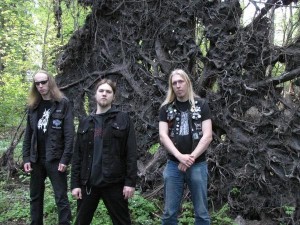 Jalas: Bolt Thrower influenced Slugathor really strongly in the beginning and always. Some people compare Slugathor also to bands like Asphyx or Obituary, but I would say that these influences are only minor and definitely more inspiration has flown, when we listened to bands such as Demigod, old Amorphis, Grave, Incantation and old Mortician. Definitely Morbid Angel also, but this was not heard so well on our music very much, I think. Also some bands, like Kaamos and Necros Christos at least influenced me in a way, because they had such unique concepts and ultimate feeling of death. Some more obscure names pop up to my mind, such as Bloody Gore (Indonesia), Darklord (Australia), all female band Mythic and so on. You know, it was all these 7″EP and demos we listened at the time besides full-length albums. Even demo-material of Dying Fetus, which could be a shock (?) to some because of their nowadays political message. But that band was brutal as hell when we first heard them. Also they were lyrically more into mutilation, etc. back then. Maybe we got into that because of teenage enthusiasm, but for some reason all this stuff still has very special place in our hearts, because they developed us to become what we are now.
Jalas: Bolt Thrower influenced Slugathor really strongly in the beginning and always. Some people compare Slugathor also to bands like Asphyx or Obituary, but I would say that these influences are only minor and definitely more inspiration has flown, when we listened to bands such as Demigod, old Amorphis, Grave, Incantation and old Mortician. Definitely Morbid Angel also, but this was not heard so well on our music very much, I think. Also some bands, like Kaamos and Necros Christos at least influenced me in a way, because they had such unique concepts and ultimate feeling of death. Some more obscure names pop up to my mind, such as Bloody Gore (Indonesia), Darklord (Australia), all female band Mythic and so on. You know, it was all these 7″EP and demos we listened at the time besides full-length albums. Even demo-material of Dying Fetus, which could be a shock (?) to some because of their nowadays political message. But that band was brutal as hell when we first heard them. Also they were lyrically more into mutilation, etc. back then. Maybe we got into that because of teenage enthusiasm, but for some reason all this stuff still has very special place in our hearts, because they developed us to become what we are now.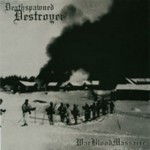 Primitive but astoundingly direct, Deathspawned Destroyer from Huittinen (home of Vordven) has with their two full lengths established Finnish parallels to grindcore influenced bands such as Blood and even Blasphemy but remained widely unnoticed because of a lack of pretension and promotion. While “The First Bestial Butchery” album indulged in gore fantasies of Finnish rural winter madness, “WarBloodMassacre” logically continues to explore real world horrors that happened within the same fields and woods we inhabit here. The shades and violent ghosts of Finnish war history 1939-1945 are not haunted, prophetic or wise in the nearly brainless, stomach churning vision of Deathspawned Destroyer. This is music and lyric of the gut, the trenches and the perpetual dirt. It is Bolt Thrower if it was created by boozing Finnish woodsmen instead of punk influenced British soccer fans. The riffs would probably tell their story as well to men who lived 10,000 years ago, provided they were fighters with hate for the scourge of slavery and love for their home woodlands. The slower parts approximate the atmospheres of Amebix brand of ethereal hardcore. The band gets a chance to try its hand at epic length composition with the more than 10 minute “Doom Before Death” and why the simplicity of structure may make progressive listeners cringe, there is hardly a criticism to be made about the way the parts are elaborated by the cruel lyrics that detail the sufferings of a prisoner of war under torture. The relentless forward driving rhythm and ghoulish voice of the band might be borrowed from the old school, but the vicious, nearly cartoonish black-and-white history flashback is something that needs to be heard to be believed.
Primitive but astoundingly direct, Deathspawned Destroyer from Huittinen (home of Vordven) has with their two full lengths established Finnish parallels to grindcore influenced bands such as Blood and even Blasphemy but remained widely unnoticed because of a lack of pretension and promotion. While “The First Bestial Butchery” album indulged in gore fantasies of Finnish rural winter madness, “WarBloodMassacre” logically continues to explore real world horrors that happened within the same fields and woods we inhabit here. The shades and violent ghosts of Finnish war history 1939-1945 are not haunted, prophetic or wise in the nearly brainless, stomach churning vision of Deathspawned Destroyer. This is music and lyric of the gut, the trenches and the perpetual dirt. It is Bolt Thrower if it was created by boozing Finnish woodsmen instead of punk influenced British soccer fans. The riffs would probably tell their story as well to men who lived 10,000 years ago, provided they were fighters with hate for the scourge of slavery and love for their home woodlands. The slower parts approximate the atmospheres of Amebix brand of ethereal hardcore. The band gets a chance to try its hand at epic length composition with the more than 10 minute “Doom Before Death” and why the simplicity of structure may make progressive listeners cringe, there is hardly a criticism to be made about the way the parts are elaborated by the cruel lyrics that detail the sufferings of a prisoner of war under torture. The relentless forward driving rhythm and ghoulish voice of the band might be borrowed from the old school, but the vicious, nearly cartoonish black-and-white history flashback is something that needs to be heard to be believed.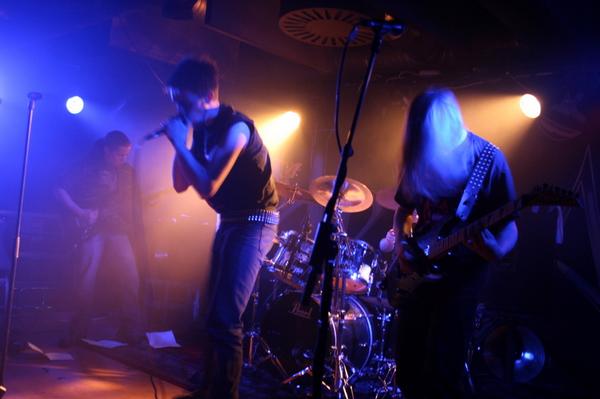 Tuomas K.: Lie in Ruins is conceptually 100% dealing with death, darkness and all things related. After all, this is Death Metal, so the lyrics and the imagery definitely should reflect that.
Tuomas K.: Lie in Ruins is conceptually 100% dealing with death, darkness and all things related. After all, this is Death Metal, so the lyrics and the imagery definitely should reflect that.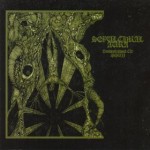 Sepulchral Aura is not the first time that mastermind J. Partanen (Second Sun, Aeoga etc.) has picked up the guitar and the drums but it’s the first time he produced a minor classic for the underground to remember from this era of harsh and esoteric Finnish metal. Cryptic, obscurant and violent atonality bursts from Partanen’s figurative composing pen much like Ligeti had developed a passion for speed metal and Death Metal, far from the technical pretensions of the Cynics and Pestilences of the world. Whoever upheld the common misconception that Death Metal is not mysteries and occult metaphor, whoever thought we needed the Black Metal “kvlt” to make us interested in life’s hidden forces and spiritual darkness, had not heard the very dimensional experience Sepulchral Aura engages us in. Lead guitars are non-musical but clear and comprehensible like alien messages sent straight into the brain cortex, vocals are guttural and rasped voices somewhere between animalism and insanity, drums sound like a tribute to old Carcass except for some very idiosyncratic ways to use rhythm and nuance to underline the chaos god that devises the riffs. It is impossible to consider a discussion of this demo that doesn’t mention the legacy of Australian Death Metal and War Metal all the way from Sadistik Exekution to the furthest reaches of Portal and Stargazer. It is very much the resurrection of the sincere belief and primal energy that fueled Bestial Warlust, but in this case consecrated by the wasteland of the North instead of the haunted chasms in Down under.
Sepulchral Aura is not the first time that mastermind J. Partanen (Second Sun, Aeoga etc.) has picked up the guitar and the drums but it’s the first time he produced a minor classic for the underground to remember from this era of harsh and esoteric Finnish metal. Cryptic, obscurant and violent atonality bursts from Partanen’s figurative composing pen much like Ligeti had developed a passion for speed metal and Death Metal, far from the technical pretensions of the Cynics and Pestilences of the world. Whoever upheld the common misconception that Death Metal is not mysteries and occult metaphor, whoever thought we needed the Black Metal “kvlt” to make us interested in life’s hidden forces and spiritual darkness, had not heard the very dimensional experience Sepulchral Aura engages us in. Lead guitars are non-musical but clear and comprehensible like alien messages sent straight into the brain cortex, vocals are guttural and rasped voices somewhere between animalism and insanity, drums sound like a tribute to old Carcass except for some very idiosyncratic ways to use rhythm and nuance to underline the chaos god that devises the riffs. It is impossible to consider a discussion of this demo that doesn’t mention the legacy of Australian Death Metal and War Metal all the way from Sadistik Exekution to the furthest reaches of Portal and Stargazer. It is very much the resurrection of the sincere belief and primal energy that fueled Bestial Warlust, but in this case consecrated by the wasteland of the North instead of the haunted chasms in Down under.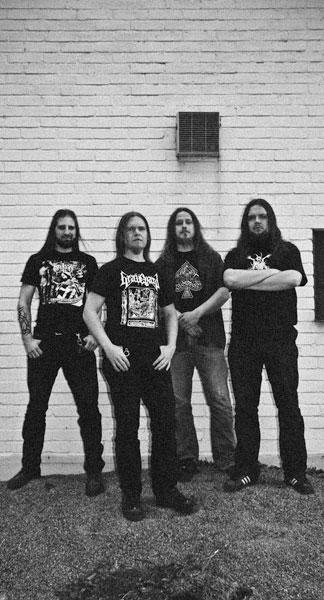 Partanen: Intent and improvisation played a major part in how the music itself turned out to be, so I cannot talk about conscious efforts of tributes to particular bands etc.
Partanen: Intent and improvisation played a major part in how the music itself turned out to be, so I cannot talk about conscious efforts of tributes to particular bands etc.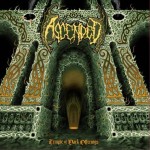 It seems sometimes like a wonder that so many Death Metal classics have been created by youngsters working on their first demo, EP or album but clearly it is a basis for less calculated and more intense statements of the primal truths these eyes have witnessed on their journey so far on earth. While the least experienced musicians on the list, Ascended from Pori prove not one bit worse in channeling the breath of exhumed grave into the nostrils of the expectant Death Metal fan. Simple but glorious, Ascended likes to keep it slow and groove onwards through melodies that recall old Tiamat, Slayer and even a bit of Black Metal. Much like Mystifier or Necros Christos, vocals intone an animated ritual chant to the dead in an almost numbingly rhythmic and non-varied manner. Sound is sparse and clear, with a surprising gap in the lower register lending the proceedings an airy, ethereal vibe of darkness. The foreboding calm of tracks such as “Wedlock of Lust” or the multi-part “Mesmerizing Stench” should be obligatory lessons for most of this generation’s Black Metal bands in what they have missed in pacing and atmospheres of evil. Technical ability and pages of morbid theology do not substitute for the realm of visions and subdued melodies that remind mortals of that which shall be over all too soon – the summer of life, clouded by the storms of the unknown, while the reaper grins to you in the horizon.
It seems sometimes like a wonder that so many Death Metal classics have been created by youngsters working on their first demo, EP or album but clearly it is a basis for less calculated and more intense statements of the primal truths these eyes have witnessed on their journey so far on earth. While the least experienced musicians on the list, Ascended from Pori prove not one bit worse in channeling the breath of exhumed grave into the nostrils of the expectant Death Metal fan. Simple but glorious, Ascended likes to keep it slow and groove onwards through melodies that recall old Tiamat, Slayer and even a bit of Black Metal. Much like Mystifier or Necros Christos, vocals intone an animated ritual chant to the dead in an almost numbingly rhythmic and non-varied manner. Sound is sparse and clear, with a surprising gap in the lower register lending the proceedings an airy, ethereal vibe of darkness. The foreboding calm of tracks such as “Wedlock of Lust” or the multi-part “Mesmerizing Stench” should be obligatory lessons for most of this generation’s Black Metal bands in what they have missed in pacing and atmospheres of evil. Technical ability and pages of morbid theology do not substitute for the realm of visions and subdued melodies that remind mortals of that which shall be over all too soon – the summer of life, clouded by the storms of the unknown, while the reaper grins to you in the horizon.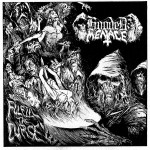 Perhaps no other themes in metal have suffered such an ugly abuse as those of gothic horror and its symbolic exploration of the unconscious, sexual and paranoid impulse within man. As plastic, theatrical and money-hungry hedonists swarmed like a pack of rats to invade Death Metal and Black Metal record labels, they left behind a legacy of fear which caused later audiences to abhor the careful and elegant treatment of the macabre that was the original intention of bands like Paradise Lost and My Dying Bride, before the same bands’ later development infused it with a homosexual taint. While Hooded Menace has not yet produced a work to outweigh the elders, it’s done more than its share in reviving hope in a form with plenty of potential. If there is one thing that has been sadly lacking in the last decade of Death Metal, it’s beautiful and clever melodies. Led by veterans from Joensuu’s progressive Death Metal cult Phlegethon, Hooded Menace pounds, thrashes and makes dramatic gestures of sweeping funereal melodies perfect for a Candlemass album while the lyrics are growled by Lasse Pyykkö (“Leper Messiah”) as absurdist anecdotes straight from 50’s B-grade horror movies.
Perhaps no other themes in metal have suffered such an ugly abuse as those of gothic horror and its symbolic exploration of the unconscious, sexual and paranoid impulse within man. As plastic, theatrical and money-hungry hedonists swarmed like a pack of rats to invade Death Metal and Black Metal record labels, they left behind a legacy of fear which caused later audiences to abhor the careful and elegant treatment of the macabre that was the original intention of bands like Paradise Lost and My Dying Bride, before the same bands’ later development infused it with a homosexual taint. While Hooded Menace has not yet produced a work to outweigh the elders, it’s done more than its share in reviving hope in a form with plenty of potential. If there is one thing that has been sadly lacking in the last decade of Death Metal, it’s beautiful and clever melodies. Led by veterans from Joensuu’s progressive Death Metal cult Phlegethon, Hooded Menace pounds, thrashes and makes dramatic gestures of sweeping funereal melodies perfect for a Candlemass album while the lyrics are growled by Lasse Pyykkö (“Leper Messiah”) as absurdist anecdotes straight from 50’s B-grade horror movies.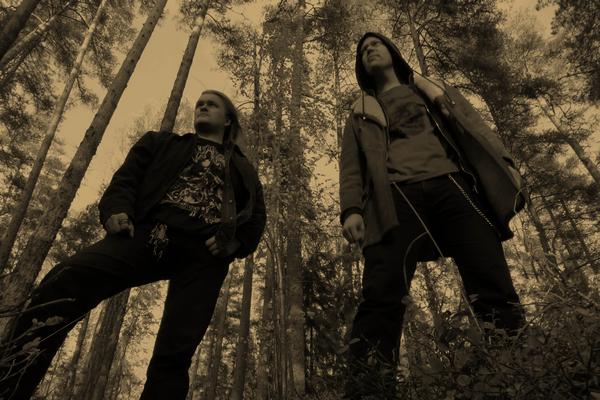 The apparent cheapness of “Grasp of the Beastwoman” or “Theme from Manhattan Baby” is offset by the care and calculation which proves that Hooded Menace has a profound affection for its infantile source material. This trait establishes a profound link with the old school of Death Metal, the musical manifestation of the gore and trash movie obsessions of kids whose awareness of the relevance of death and morbidity to philosophical discourse was only intuitive and spontaneous.
The apparent cheapness of “Grasp of the Beastwoman” or “Theme from Manhattan Baby” is offset by the care and calculation which proves that Hooded Menace has a profound affection for its infantile source material. This trait establishes a profound link with the old school of Death Metal, the musical manifestation of the gore and trash movie obsessions of kids whose awareness of the relevance of death and morbidity to philosophical discourse was only intuitive and spontaneous.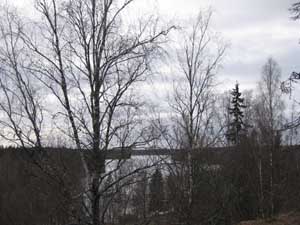 While most media continues to highlight the hyped up Heavy, Black and Doom bands from the Land of the Thousand Lakes, we at Deathmetal.Org wish to raise a mighty salute to the legions of blasphemy and resistance who are spreading evil Death Metal amidst the wastelands of the frozen North. Unique, demanding and powerful, these bands are not in the way to become the next big thing in Death Metal, but I have the sincere hope that each reader will find something in this diverse assortment that speaks to him in the voice of transcendental communication which is the reason we have been interested in this art for all these years. These hordes will either dominate the world or rule in shadows.
While most media continues to highlight the hyped up Heavy, Black and Doom bands from the Land of the Thousand Lakes, we at Deathmetal.Org wish to raise a mighty salute to the legions of blasphemy and resistance who are spreading evil Death Metal amidst the wastelands of the frozen North. Unique, demanding and powerful, these bands are not in the way to become the next big thing in Death Metal, but I have the sincere hope that each reader will find something in this diverse assortment that speaks to him in the voice of transcendental communication which is the reason we have been interested in this art for all these years. These hordes will either dominate the world or rule in shadows.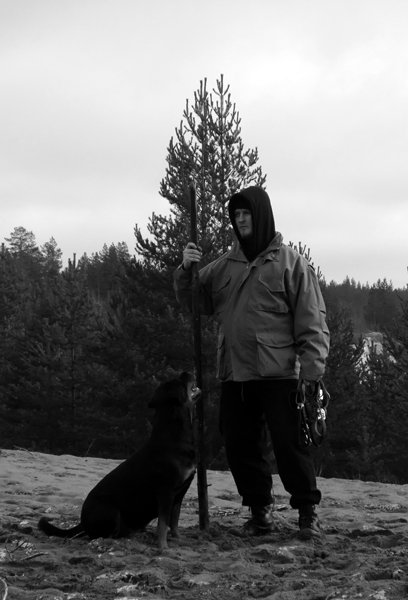 Haavisto: Once Lehtinen quit playing after the second Deathspawned Destroyer album, it meant an almost complete stop to our activity. We did two promising tracks with our new member Tuomas Murtojärvi, but we didn’t really get it properly going so the band and the Death Metal spirit has drifted away. People tend to have so much other things to do and the most important band related people have moved so far from us that when we have the occasional practice we play something totally different from Deathspawned Destroyer. The modern day Death Metal people seem anyway to be in a different world and there doesn’t seem to be a demand for old school ruckus. At least not among the “metalheads” seen in the streets around here. I haven’t followed either the recent developments in Death Metal, because the new bands don’t interest me one bit and the old ones have been devoured through and through many times. Deathspawned Destroyer rests in the shadows and maybe one day will be back and do something worth listening to… maybe. We need a guitarist who has a regular commitment to the project and who cares more about the attitude than playing right. It’s certain that things won’t work out again with the original Deathspawned Destroyer duo, but there’s no strife related to it. Hails to Lehtinen and everyone else who supported Deathspawned Destroyer and were a part of our activity in one way or another!
Haavisto: Once Lehtinen quit playing after the second Deathspawned Destroyer album, it meant an almost complete stop to our activity. We did two promising tracks with our new member Tuomas Murtojärvi, but we didn’t really get it properly going so the band and the Death Metal spirit has drifted away. People tend to have so much other things to do and the most important band related people have moved so far from us that when we have the occasional practice we play something totally different from Deathspawned Destroyer. The modern day Death Metal people seem anyway to be in a different world and there doesn’t seem to be a demand for old school ruckus. At least not among the “metalheads” seen in the streets around here. I haven’t followed either the recent developments in Death Metal, because the new bands don’t interest me one bit and the old ones have been devoured through and through many times. Deathspawned Destroyer rests in the shadows and maybe one day will be back and do something worth listening to… maybe. We need a guitarist who has a regular commitment to the project and who cares more about the attitude than playing right. It’s certain that things won’t work out again with the original Deathspawned Destroyer duo, but there’s no strife related to it. Hails to Lehtinen and everyone else who supported Deathspawned Destroyer and were a part of our activity in one way or another!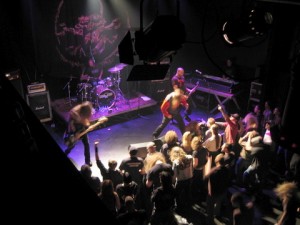 Entombed played a set that disappointed, and this was partially due a lack of their better material being played. Much of the setlist consisted of numbers that were lifted from their third full-length, Wolverine Blues and then onwards, with a lack of attention given to their more pioneering work that was put out on their first two albums, Left Hand Path and Clandestine. Songs were less death metal than they were an aggressive take on stoner rock, songs being much more inclined to the verse/chorus school of rock songwriting, the rhythms more inclined to provoke the shaking of hips and the tapping of feet than they were to bang heads. Whilst this was all good and competent, certainly the great soundtrack of an alcohol fueled evening in the capital of Eire, none of these works, as far as the reviewers opinion is concerned had the violent charge nor the momentum that characterized their legendary debut. Some credit will be given to the vocalist, whose onstage presence and frantic onstage manners gave more depth and urgency to songs that otherwise were devoid of it, and the guitarists tone was brilliant, the same buzzing, ‘chainsaw’ like tone that they helped pioneer back in the early nineties through maximum amplification. Entombed concluded their set with a brilliant rendition of Left Hand Path the staple and title track of their debut album, and it put a redeeming conclusion to what was an expertly performed, yet borderline mediocre set on occasions. It would be wonderful to hear what paths could be treaded if they realise the urgency that made their earlier music essential.
Entombed played a set that disappointed, and this was partially due a lack of their better material being played. Much of the setlist consisted of numbers that were lifted from their third full-length, Wolverine Blues and then onwards, with a lack of attention given to their more pioneering work that was put out on their first two albums, Left Hand Path and Clandestine. Songs were less death metal than they were an aggressive take on stoner rock, songs being much more inclined to the verse/chorus school of rock songwriting, the rhythms more inclined to provoke the shaking of hips and the tapping of feet than they were to bang heads. Whilst this was all good and competent, certainly the great soundtrack of an alcohol fueled evening in the capital of Eire, none of these works, as far as the reviewers opinion is concerned had the violent charge nor the momentum that characterized their legendary debut. Some credit will be given to the vocalist, whose onstage presence and frantic onstage manners gave more depth and urgency to songs that otherwise were devoid of it, and the guitarists tone was brilliant, the same buzzing, ‘chainsaw’ like tone that they helped pioneer back in the early nineties through maximum amplification. Entombed concluded their set with a brilliant rendition of Left Hand Path the staple and title track of their debut album, and it put a redeeming conclusion to what was an expertly performed, yet borderline mediocre set on occasions. It would be wonderful to hear what paths could be treaded if they realise the urgency that made their earlier music essential.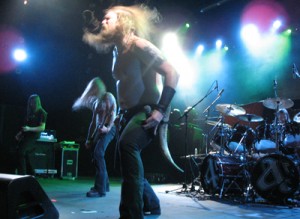 Amon Amarth played an excellent and intense set, mostly consisting of the melodic, fluid and anthemic traditional metal that they have come to be easily associated with. Infectious melodies and precise, double-bass lead drum rhythms bring to mind a hybrid of Blind Guardian and late period Immortal, whilst the muscle and simplicity of their music brings to mind fellow countrymen Unleashed in both the subject matter and the simplicity of the song structures. Musically Amon Amarth have an obvious strong commercial potential, sound highly accessible by the subgenre’s standards, and whilst they are not exactly breaking any new artistic ground, they are still workmanlike and this shows in what was a very well received and well performed set. Johan Hegg is a good front man and throughout the set uses the opportunity to incite the audience to terrace chant amidst his bellowing, whilst taking turns to consume from the mead horn that is his custom to bring on stage with him. Admittedly I would not consider these to be an act of the highest caliber, though they are unique in that they have one foot stood in the primitive and barbaric, with one firmly in the ability to reach out to a large audience. It was a privilege to be involved among the audience that night.
Amon Amarth played an excellent and intense set, mostly consisting of the melodic, fluid and anthemic traditional metal that they have come to be easily associated with. Infectious melodies and precise, double-bass lead drum rhythms bring to mind a hybrid of Blind Guardian and late period Immortal, whilst the muscle and simplicity of their music brings to mind fellow countrymen Unleashed in both the subject matter and the simplicity of the song structures. Musically Amon Amarth have an obvious strong commercial potential, sound highly accessible by the subgenre’s standards, and whilst they are not exactly breaking any new artistic ground, they are still workmanlike and this shows in what was a very well received and well performed set. Johan Hegg is a good front man and throughout the set uses the opportunity to incite the audience to terrace chant amidst his bellowing, whilst taking turns to consume from the mead horn that is his custom to bring on stage with him. Admittedly I would not consider these to be an act of the highest caliber, though they are unique in that they have one foot stood in the primitive and barbaric, with one firmly in the ability to reach out to a large audience. It was a privilege to be involved among the audience that night.





































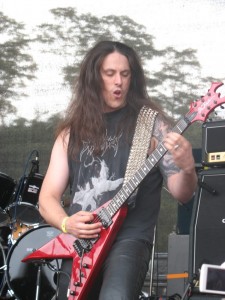 Every rock fan knows
Every rock fan knows 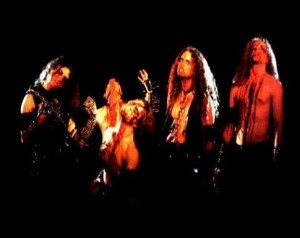 Influenced by hardcore and speed metal, these madmen from Sydney proceeded to destroy the reputability of Australian metal with their on-stage and off-stage antics, almost becoming performance art with their macabre, sarcastic terror campaign of pure noise. Already
Influenced by hardcore and speed metal, these madmen from Sydney proceeded to destroy the reputability of Australian metal with their on-stage and off-stage antics, almost becoming performance art with their macabre, sarcastic terror campaign of pure noise. Already 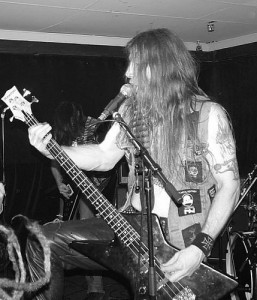 All this might have you thinking that the Nordic and Romantic styles of black metal were obsolete in Australia, but this was not to be the case. Abyssic Hate (whose “Cleansing with an Ancient Race” was a perfect match for the Immortal related Det Hedenske Folk on their split album) intended to capture the harsh poetry of Burzum and Ildjarn. Later material was somewhat unsuccessful because of humanocentric (“suicidal”) terminology, despite ambient leanings in songwriting. Nazxul was the Australian counterpart to mysticist bands like Nåstrond or
All this might have you thinking that the Nordic and Romantic styles of black metal were obsolete in Australia, but this was not to be the case. Abyssic Hate (whose “Cleansing with an Ancient Race” was a perfect match for the Immortal related Det Hedenske Folk on their split album) intended to capture the harsh poetry of Burzum and Ildjarn. Later material was somewhat unsuccessful because of humanocentric (“suicidal”) terminology, despite ambient leanings in songwriting. Nazxul was the Australian counterpart to mysticist bands like Nåstrond or 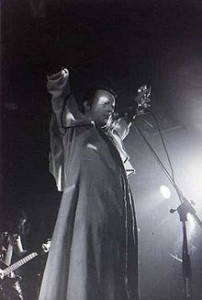 Gradually, we can note the presence of all the international metal trends and hypes increasing in Australia, filling the continent with meaningless bands. It would be a lie to say that the random band you hear from Australia is up to anything good. But there’s some you might like to hear. Asphyxia is a young technical death metal band, influenced by Nile, Kataklysm and the rest of the champions of convoluted hyperspeed – they are bit in love with the Necrophagist digital treachery fashion but they have room to develop and the players definitely deserve applause for their instrumental excursion. Midnight Odyssey uses oceanic layers of slow melody to transform black metal to a landscape of dark clouds, using keyboards in the evocative manner familiar from Schulze and Summoning. The best of the epics on “Firmament” rediscover a youthful, hopeful beauty that hasn’t been too fashionable in the image and commodity oriented latter days of black and death metal. Nazxul, who sadly lost a vital member to a motorcycle accident, released in 2009 their possible magnum opus, the immense “Iconoclast” which has established itself as one of my top black metal choices of the year despite initial skepticism towards the more standard imagery and vocabulary employed on the surface. Suggestively classical and elegant, as Emperor and Avzhia did it, Nazxul praise the unliving and the unknown with a Bach-ian playful sonority, adding themes, keyboards and guitar leads to basically simple songs the same way an alchemist adds prime materials to his boiling tincture of salvation. It is all, and much more, than most of
Gradually, we can note the presence of all the international metal trends and hypes increasing in Australia, filling the continent with meaningless bands. It would be a lie to say that the random band you hear from Australia is up to anything good. But there’s some you might like to hear. Asphyxia is a young technical death metal band, influenced by Nile, Kataklysm and the rest of the champions of convoluted hyperspeed – they are bit in love with the Necrophagist digital treachery fashion but they have room to develop and the players definitely deserve applause for their instrumental excursion. Midnight Odyssey uses oceanic layers of slow melody to transform black metal to a landscape of dark clouds, using keyboards in the evocative manner familiar from Schulze and Summoning. The best of the epics on “Firmament” rediscover a youthful, hopeful beauty that hasn’t been too fashionable in the image and commodity oriented latter days of black and death metal. Nazxul, who sadly lost a vital member to a motorcycle accident, released in 2009 their possible magnum opus, the immense “Iconoclast” which has established itself as one of my top black metal choices of the year despite initial skepticism towards the more standard imagery and vocabulary employed on the surface. Suggestively classical and elegant, as Emperor and Avzhia did it, Nazxul praise the unliving and the unknown with a Bach-ian playful sonority, adding themes, keyboards and guitar leads to basically simple songs the same way an alchemist adds prime materials to his boiling tincture of salvation. It is all, and much more, than most of 




















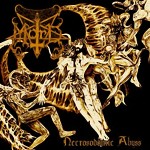 The new Osmose recruits Mord seem to have been actually born in Poland, then relocated to near Kristiansand, which is remembered as the location of a violent death metal sect in support of Varg Vikernes back in 1991 and the origin of Tchort (Blood Red Throne, Emperor, Green Carnation). Not quite living up to the bloody and progressive traditions of the area, Mord specializes in a cold, modern, thrashed-out black metal sound that could scientifically have been developed in a norsecore factory to create an endless amount of productive clones. Maybe because they are originally from Poland, they do seem to possess a better grasp of what makes Nordic black metal good than most Scandinavians around exhibit. They keep the album vile and to the point, imitating the blasphemous rhythm guitar of, besides Euronymous, Ivar Bjørnson during the phase of Enslaved when they dropped most of their classical influence and switched to riff rock. Later Ancient springs to mind in tracks such as “Opus II” which is essentially is a meeting of pop and black metal in a graveyard infested with drunked teenagers who wear makeup and like to flash stupid expressions in photos. It may sound bad but in fact, as guitar rock or something, it excels. It is simply lacking in the Romantic nature worship, warrior ideology and mysticism of Burzum, Ildjarn and the other greats. So while musically this has potential for an above average Norwegian black metal album (even though these ideas are 15 years late) it ends up as one more relic that brings black metal closer to mainstream acceptance and youth culture phenomena today, and no-one will remember it in ten years.
The new Osmose recruits Mord seem to have been actually born in Poland, then relocated to near Kristiansand, which is remembered as the location of a violent death metal sect in support of Varg Vikernes back in 1991 and the origin of Tchort (Blood Red Throne, Emperor, Green Carnation). Not quite living up to the bloody and progressive traditions of the area, Mord specializes in a cold, modern, thrashed-out black metal sound that could scientifically have been developed in a norsecore factory to create an endless amount of productive clones. Maybe because they are originally from Poland, they do seem to possess a better grasp of what makes Nordic black metal good than most Scandinavians around exhibit. They keep the album vile and to the point, imitating the blasphemous rhythm guitar of, besides Euronymous, Ivar Bjørnson during the phase of Enslaved when they dropped most of their classical influence and switched to riff rock. Later Ancient springs to mind in tracks such as “Opus II” which is essentially is a meeting of pop and black metal in a graveyard infested with drunked teenagers who wear makeup and like to flash stupid expressions in photos. It may sound bad but in fact, as guitar rock or something, it excels. It is simply lacking in the Romantic nature worship, warrior ideology and mysticism of Burzum, Ildjarn and the other greats. So while musically this has potential for an above average Norwegian black metal album (even though these ideas are 15 years late) it ends up as one more relic that brings black metal closer to mainstream acceptance and youth culture phenomena today, and no-one will remember it in ten years.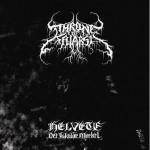 While the gloomy shroud of 21st century black metal clichés weighs like lead upon Throne of Katarsis, a sense of ambition and greatness, the carefully followed tread of frozen melody including an airy vastness copied from In the Nightside Eclipse or early Taake and some elegant and progressive forms makes this rise above the level of total weakness. Like Isvind and Tsjuder, Throne of Katarsis explore the melodic territory in between Darkthrone and Emperor in an effort to replicate the impression of transcendent evil boiling in the depths. Fast percussion underlies the sonic depression of dubiously plodding, soaring but monotone and unenergetic low production (Grieghallen copy) guitars repeating spherical themes (rotating the minor chords “De Mysteriis” style during the slow parts over and over again to give the melancholic feeling) over to vastness. The best of the musical ideas are hidden by the desire to create a standard black metal album, as they probably succumbed to creating an album too quickly and thinking that it’s enough to put out cold and intensity-devouring two-penny riffs that have been overused for 20 years – bulk Norwegian black metal in good and bad.
While the gloomy shroud of 21st century black metal clichés weighs like lead upon Throne of Katarsis, a sense of ambition and greatness, the carefully followed tread of frozen melody including an airy vastness copied from In the Nightside Eclipse or early Taake and some elegant and progressive forms makes this rise above the level of total weakness. Like Isvind and Tsjuder, Throne of Katarsis explore the melodic territory in between Darkthrone and Emperor in an effort to replicate the impression of transcendent evil boiling in the depths. Fast percussion underlies the sonic depression of dubiously plodding, soaring but monotone and unenergetic low production (Grieghallen copy) guitars repeating spherical themes (rotating the minor chords “De Mysteriis” style during the slow parts over and over again to give the melancholic feeling) over to vastness. The best of the musical ideas are hidden by the desire to create a standard black metal album, as they probably succumbed to creating an album too quickly and thinking that it’s enough to put out cold and intensity-devouring two-penny riffs that have been overused for 20 years – bulk Norwegian black metal in good and bad.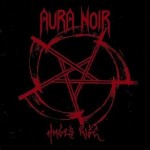 I do remember the Apollyon/Aggressor duo Aura Noir as a high-energy, motor powered and tradition respecting black metal cult from the days of the bewitching “Dreams Like Deserts” MCD, never afraid to rock out nor experiment with unusual guitar and drum techniques – even cross-quoting with Ved Buens Ende material. Something really devastating has happened and I don’t know if it has to do with Aggressor’s falling down from a balcony or something, but they sound totally drunk, tired and old on this album. I mean, if you think that Darkthrone nowadays sounds like a lazy beer-swilling band from the pub, try this one! I can hear they are trying to play like Sodom, but I can’t hear any Germanic “raaaaaah!” mania. I can hear Autopsy, but I can’t hear the stinking amputated corpses rising all around to wreak their vengeance upon the societies of the living. I can hear hardcore, but I can’t hear the decisive violent power of wrath against conformity. So, what is there left? It sounds a bit Southern Lord-y – you know, ironic old metal fan hipster who likes to get stoned out of his mind and listen to feel-good old-times metal. By the way, the drum production sounds like MIDI – utter failure. If you want real speed/black metal power, go for the originals, this one is a weak joke.
I do remember the Apollyon/Aggressor duo Aura Noir as a high-energy, motor powered and tradition respecting black metal cult from the days of the bewitching “Dreams Like Deserts” MCD, never afraid to rock out nor experiment with unusual guitar and drum techniques – even cross-quoting with Ved Buens Ende material. Something really devastating has happened and I don’t know if it has to do with Aggressor’s falling down from a balcony or something, but they sound totally drunk, tired and old on this album. I mean, if you think that Darkthrone nowadays sounds like a lazy beer-swilling band from the pub, try this one! I can hear they are trying to play like Sodom, but I can’t hear any Germanic “raaaaaah!” mania. I can hear Autopsy, but I can’t hear the stinking amputated corpses rising all around to wreak their vengeance upon the societies of the living. I can hear hardcore, but I can’t hear the decisive violent power of wrath against conformity. So, what is there left? It sounds a bit Southern Lord-y – you know, ironic old metal fan hipster who likes to get stoned out of his mind and listen to feel-good old-times metal. By the way, the drum production sounds like MIDI – utter failure. If you want real speed/black metal power, go for the originals, this one is a weak joke.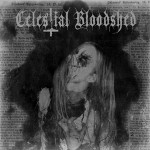 It would be quite interesting to see if someone, somewhere in Norway, has during the year released black metal or death metal which does not a) try to duplicate the old Grieghallen soundscape with in the most generic no-sense-of-style manner, b) fill their album with a load of budget riffs called depressive black metal by the kids (which is actually C, D, E minor again… and again…). Anyway, while Celestial Bloodshed has ripped off these ideas from better bands, they are 50% better in their songcraft than Watain, Funeral Mist and other generic black metal of the era. Also, they have been able to create inner beauty towards the realization of the music in melodic intensity. Additionally, the fullness of the soundscape and the implications of the structure make this release more grim, oppressive and grinding than the mainsteam manipulations of Norwegian metal which can not be but a good thing. After a beautiful intro which sounds somewhat like one of the demos from Equimanthorn (Absu members’ ritual project) the album pounds into a lexicon of guitar techniques borrowed from a range of musicians from Mayhem to Enslaved, with a dynamic range from slow romantic soulseeking to blasphemous speeds, sometimes bridged with jarring changes, while death metal influenced vicious, likeable and personal (down to some insistent mannerisms) vocals pace like hammer upon an anvil the grim predictions of mortal future and the drummer operates battery like Faust and Hellhammer used to in the early 90′s. While all of this is not fully developed yet into pure communication, it speaks with instant, amazed, satanic impressions of life facing the darkness of Infinity – Celestial Bloodshed has replicated the old school with care, honesty and vicious intent.
It would be quite interesting to see if someone, somewhere in Norway, has during the year released black metal or death metal which does not a) try to duplicate the old Grieghallen soundscape with in the most generic no-sense-of-style manner, b) fill their album with a load of budget riffs called depressive black metal by the kids (which is actually C, D, E minor again… and again…). Anyway, while Celestial Bloodshed has ripped off these ideas from better bands, they are 50% better in their songcraft than Watain, Funeral Mist and other generic black metal of the era. Also, they have been able to create inner beauty towards the realization of the music in melodic intensity. Additionally, the fullness of the soundscape and the implications of the structure make this release more grim, oppressive and grinding than the mainsteam manipulations of Norwegian metal which can not be but a good thing. After a beautiful intro which sounds somewhat like one of the demos from Equimanthorn (Absu members’ ritual project) the album pounds into a lexicon of guitar techniques borrowed from a range of musicians from Mayhem to Enslaved, with a dynamic range from slow romantic soulseeking to blasphemous speeds, sometimes bridged with jarring changes, while death metal influenced vicious, likeable and personal (down to some insistent mannerisms) vocals pace like hammer upon an anvil the grim predictions of mortal future and the drummer operates battery like Faust and Hellhammer used to in the early 90′s. While all of this is not fully developed yet into pure communication, it speaks with instant, amazed, satanic impressions of life facing the darkness of Infinity – Celestial Bloodshed has replicated the old school with care, honesty and vicious intent.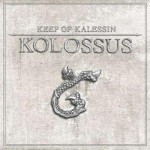 Keep of Kalessin arouse my interest during their demo days, as 1997′s “Skygger av Sorg” repeated the style of old Satyricon in a series of simple, emotional song fragments that revealed a sad beauty lying underneath the grim soundscape. I had heard some less interesting newer material but it is truly shocking what they have submerged into now – an arrogant, over-produced tribute to the honor of Greek warriors through quasi-talented commercial death metal. Synth washes and expressive vocals (in the vein of Nergal when he’s really pissed off in the later Behemoth albums) fill this piece of plastic because they want to sound big and they want to play on a stadium. I am convinced that someone with their musicianship should be able to create a listenable and consistent album, but these super fast blastbeats and commercial heavy metal oriented song dynamics from quiet to loud make this just a faux extreme version of something like Spearhead or Deströyer 666, made worse by the angry shouter vocalist. The people interested only in dry technique and production standards will love this for being an emphatic and empty opera of sharp drumwork and the constantly shifting death metal type fast guitars and entertainment value. They are also happy that it lacks the primal natural force of old Norwegian metal, because it might be distrubing. The sense of space created should be one of a studio or a big venue, instead of a woodland crypt, right? This amount of polishing emphasizes the superficiality of the entire composure, down to metalcore action computer game synchronized by MIDI in Kolossus, where accurate but inconsequential fast drum beats follow cheap-ass tremolo melodies from the pits of norsecore Hell and the vocalist sounds angry at people at the nearby mall and emo pop chorus in “Ascendant” which doesn’t even fit the music underneath. Likewise the arabic solos in the middle part of “Kolossus” don’t seem to have anything to do with the metal riffs, nor do the “300″ soundtrack reminiscent bits with synths and tablas. Whoever has produced this must be a commercial minded jerk.
Keep of Kalessin arouse my interest during their demo days, as 1997′s “Skygger av Sorg” repeated the style of old Satyricon in a series of simple, emotional song fragments that revealed a sad beauty lying underneath the grim soundscape. I had heard some less interesting newer material but it is truly shocking what they have submerged into now – an arrogant, over-produced tribute to the honor of Greek warriors through quasi-talented commercial death metal. Synth washes and expressive vocals (in the vein of Nergal when he’s really pissed off in the later Behemoth albums) fill this piece of plastic because they want to sound big and they want to play on a stadium. I am convinced that someone with their musicianship should be able to create a listenable and consistent album, but these super fast blastbeats and commercial heavy metal oriented song dynamics from quiet to loud make this just a faux extreme version of something like Spearhead or Deströyer 666, made worse by the angry shouter vocalist. The people interested only in dry technique and production standards will love this for being an emphatic and empty opera of sharp drumwork and the constantly shifting death metal type fast guitars and entertainment value. They are also happy that it lacks the primal natural force of old Norwegian metal, because it might be distrubing. The sense of space created should be one of a studio or a big venue, instead of a woodland crypt, right? This amount of polishing emphasizes the superficiality of the entire composure, down to metalcore action computer game synchronized by MIDI in Kolossus, where accurate but inconsequential fast drum beats follow cheap-ass tremolo melodies from the pits of norsecore Hell and the vocalist sounds angry at people at the nearby mall and emo pop chorus in “Ascendant” which doesn’t even fit the music underneath. Likewise the arabic solos in the middle part of “Kolossus” don’t seem to have anything to do with the metal riffs, nor do the “300″ soundtrack reminiscent bits with synths and tablas. Whoever has produced this must be a commercial minded jerk.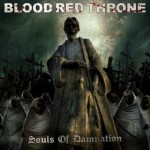 Tchort from Kristiansand was a newcomer to the death metal scene with his band Green Carnation right when the genre went out of fashion because of Euronymous’ hatefulness towards it and while that name was resurrected for Tchort’s progressive metal project he formed the neo-death metal group Blood Red Throne at the end of the millennium. While not having heard the early Green Carnation material, it’s easy to hear from this that some trace of early influence from excellent bands like Grave and Cadaver does exist, but none of their ability to turn basic riff structures into progressive and morbid magic. This type of song construction mostly resembles Cannibal Corpse and Deicide during the latter’s worst days of In Torment In Hell, filling songs with groovy mosh parts, faux-brutal growls and the drummer and bass player (from Deeds of Flesh) insisting wimpily on always playing to the beat of the riff. If this is the king on Norway’s death metal throne since Cadaver disbanded, it is quite sad actually. Most good (death) metal is memorable from its melodies, however convoluted and vicious they may be, but Souls of Damnation is mostly simple rhythmic phrases like guitar exercise patterns for introducing mechanical creation technique for sub-Florida death metal. Like all boring death metal, it severely underestimates its audience. I mean, many listeners do like death metal that sounds like basic no-frills brutal grind, but this worthless chugging goes too far. It seems like the whole album lacks even one interesting melody part or arrangement.
Tchort from Kristiansand was a newcomer to the death metal scene with his band Green Carnation right when the genre went out of fashion because of Euronymous’ hatefulness towards it and while that name was resurrected for Tchort’s progressive metal project he formed the neo-death metal group Blood Red Throne at the end of the millennium. While not having heard the early Green Carnation material, it’s easy to hear from this that some trace of early influence from excellent bands like Grave and Cadaver does exist, but none of their ability to turn basic riff structures into progressive and morbid magic. This type of song construction mostly resembles Cannibal Corpse and Deicide during the latter’s worst days of In Torment In Hell, filling songs with groovy mosh parts, faux-brutal growls and the drummer and bass player (from Deeds of Flesh) insisting wimpily on always playing to the beat of the riff. If this is the king on Norway’s death metal throne since Cadaver disbanded, it is quite sad actually. Most good (death) metal is memorable from its melodies, however convoluted and vicious they may be, but Souls of Damnation is mostly simple rhythmic phrases like guitar exercise patterns for introducing mechanical creation technique for sub-Florida death metal. Like all boring death metal, it severely underestimates its audience. I mean, many listeners do like death metal that sounds like basic no-frills brutal grind, but this worthless chugging goes too far. It seems like the whole album lacks even one interesting melody part or arrangement.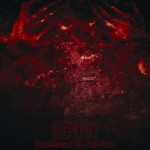 One of the newer Oslo bands mostly known from relentless and uncompromising fast black metal, 1349 surprise with their latest effort in refusing to conform to the rules of the flock. This time conjuring echoes of Samael’s Ceremony of Opposites and later Mayhem, 1349 composes suffocated, devilish and industrial tinged black metal sounds which despite being somewhat predictable, retain the doomy beauty of an industry of inferno. The loneliness of space as described in Moorcock’s trippy novel “The Black Corridor” and the classic fantasy movie “Alien” fill this Gigerian landscape of planets, threats and biomechanical blasphemies. Bodies twitch into contorted positions in a sea of light. The psychedelic feel is enhanced by a cover of Pink Floyd’s “Set the Controls for the Heart of Sun” featuring Tom G. Warrior. Several tracks use minutes to unfold submerged ambient and experimental soundscapes, while there is some Red Harvest type digital manipulation featured in many of the metal songs too. The arrangement is dramatic and regal, with Frost’s drumming skills put to good use. Multiple vocal styles herald the theatrical nature. Some interesting lead guitars add desperate wails to the background. Some parts are in their wicked minimalism close to what one could also expect to, say, Beherit to compose if he were in a more commercial high budget recording project, making this one of the more worthwhile efforts from Norway last year in producing new vistas of black metal.
One of the newer Oslo bands mostly known from relentless and uncompromising fast black metal, 1349 surprise with their latest effort in refusing to conform to the rules of the flock. This time conjuring echoes of Samael’s Ceremony of Opposites and later Mayhem, 1349 composes suffocated, devilish and industrial tinged black metal sounds which despite being somewhat predictable, retain the doomy beauty of an industry of inferno. The loneliness of space as described in Moorcock’s trippy novel “The Black Corridor” and the classic fantasy movie “Alien” fill this Gigerian landscape of planets, threats and biomechanical blasphemies. Bodies twitch into contorted positions in a sea of light. The psychedelic feel is enhanced by a cover of Pink Floyd’s “Set the Controls for the Heart of Sun” featuring Tom G. Warrior. Several tracks use minutes to unfold submerged ambient and experimental soundscapes, while there is some Red Harvest type digital manipulation featured in many of the metal songs too. The arrangement is dramatic and regal, with Frost’s drumming skills put to good use. Multiple vocal styles herald the theatrical nature. Some interesting lead guitars add desperate wails to the background. Some parts are in their wicked minimalism close to what one could also expect to, say, Beherit to compose if he were in a more commercial high budget recording project, making this one of the more worthwhile efforts from Norway last year in producing new vistas of black metal.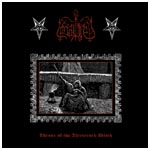 This little EP from Mare, one of the infamous Trondheim cults tends to sound a bit like Live in Leipzig era Mayhem recording in a sewer infested with rats and worms and the decrepit and rotten soundscape makes this one an aesthetically more attractive listen than most of the studio produced turds. Intuitively they grasp the idea of structuring long songs in the old Emperor vein so that while the bits and pieces are redundant, it is a journey through minimalist music themes into the realization and acceptance of the power of darkness. Slow, crawling, anti-logical repetition of simple melody (where the keyboards add a tasteful of old Enslaved) make it a bit of an un-musical experience – the composition seems to be mostly oriented to the fans of droning soundscape whereas the planning and calculation in the overstated reverb, vocal sound (while Kvitrim is good at pacing) and lack of invention in the riffs suggest seem to be aimed for the black metal consumer. But it is deconstructive, degenerate and deceitful music – for pure ideas, about as good as the best of the bunch reviewed here. An ambience and sense of space is reached, the Faustian concept of man as a warrior who travels and explores the universe, only to relinquish his individuality to the higher natural order – in death and rebirth.
This little EP from Mare, one of the infamous Trondheim cults tends to sound a bit like Live in Leipzig era Mayhem recording in a sewer infested with rats and worms and the decrepit and rotten soundscape makes this one an aesthetically more attractive listen than most of the studio produced turds. Intuitively they grasp the idea of structuring long songs in the old Emperor vein so that while the bits and pieces are redundant, it is a journey through minimalist music themes into the realization and acceptance of the power of darkness. Slow, crawling, anti-logical repetition of simple melody (where the keyboards add a tasteful of old Enslaved) make it a bit of an un-musical experience – the composition seems to be mostly oriented to the fans of droning soundscape whereas the planning and calculation in the overstated reverb, vocal sound (while Kvitrim is good at pacing) and lack of invention in the riffs suggest seem to be aimed for the black metal consumer. But it is deconstructive, degenerate and deceitful music – for pure ideas, about as good as the best of the bunch reviewed here. An ambience and sense of space is reached, the Faustian concept of man as a warrior who travels and explores the universe, only to relinquish his individuality to the higher natural order – in death and rebirth.
